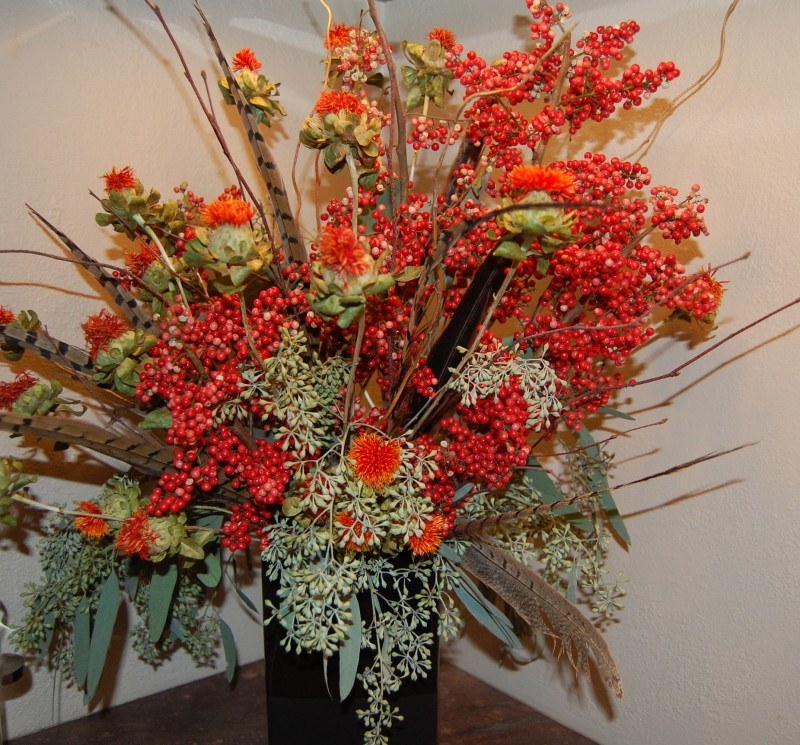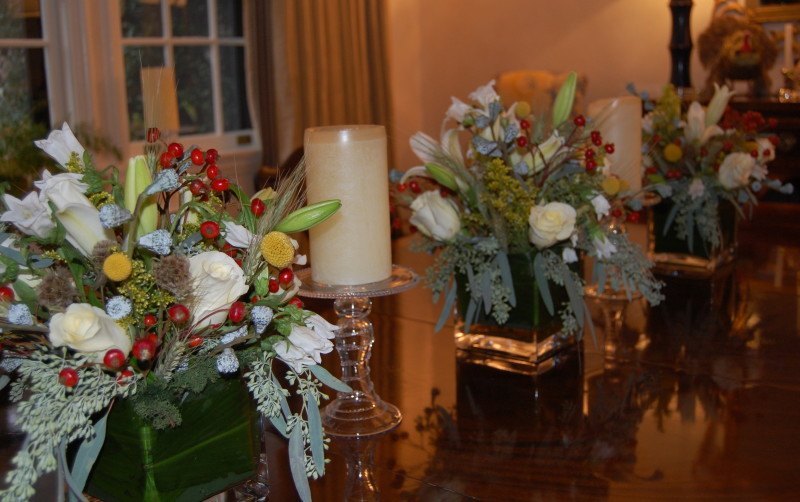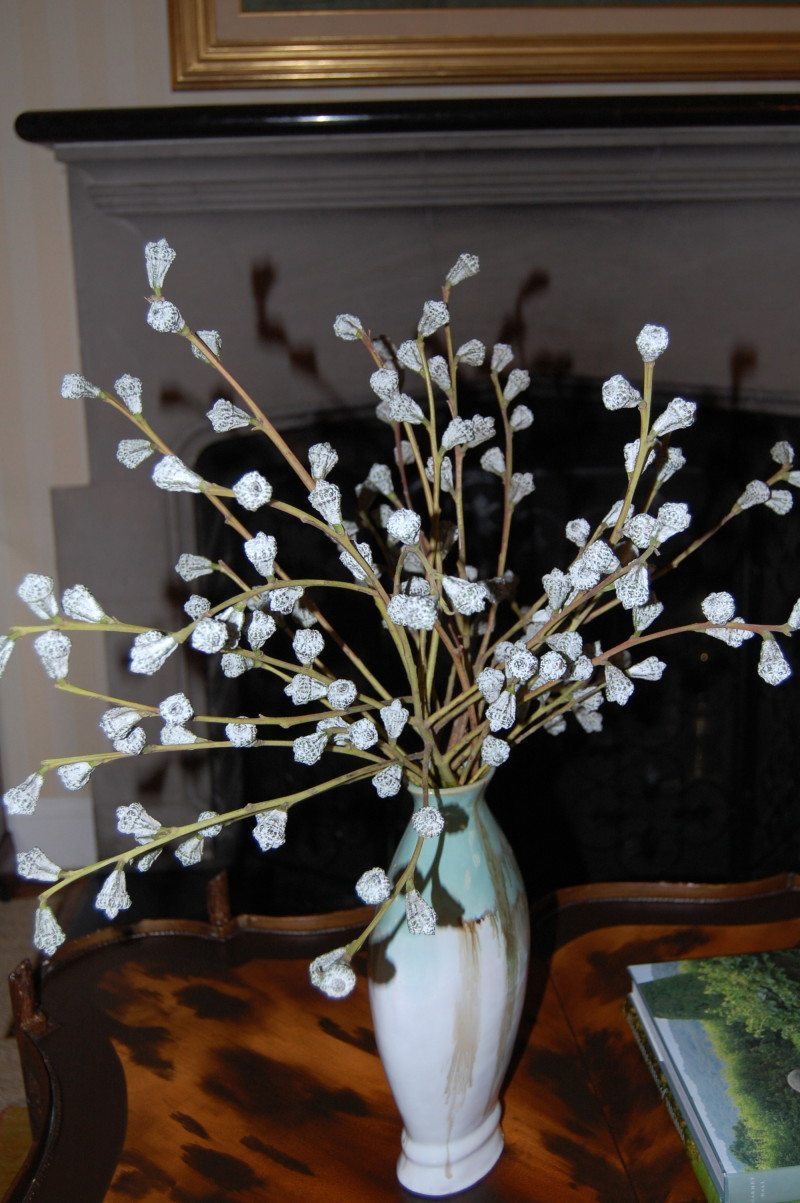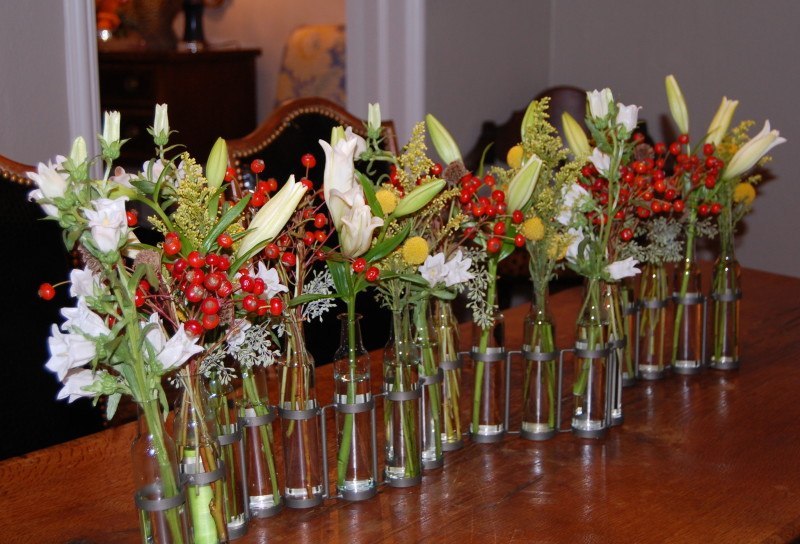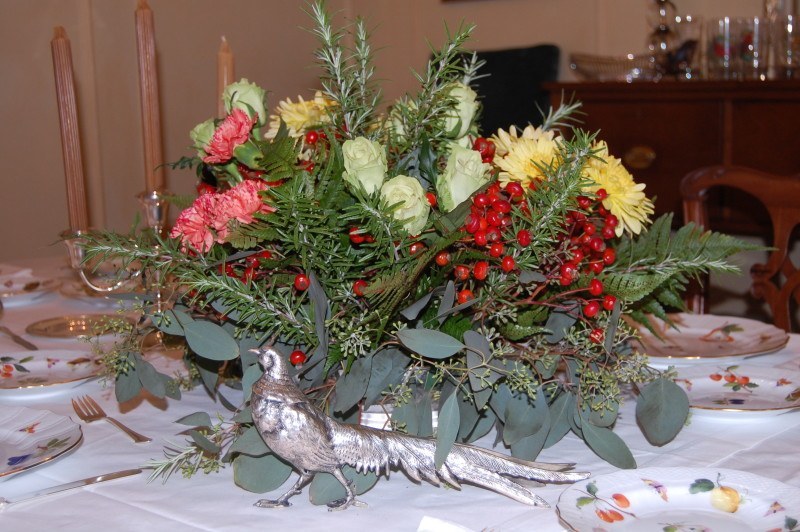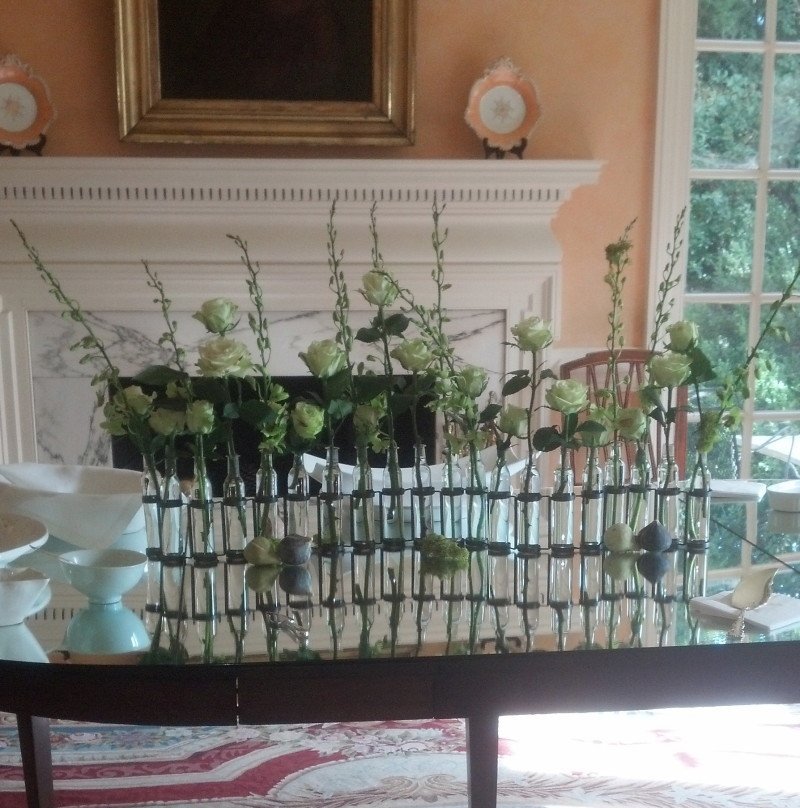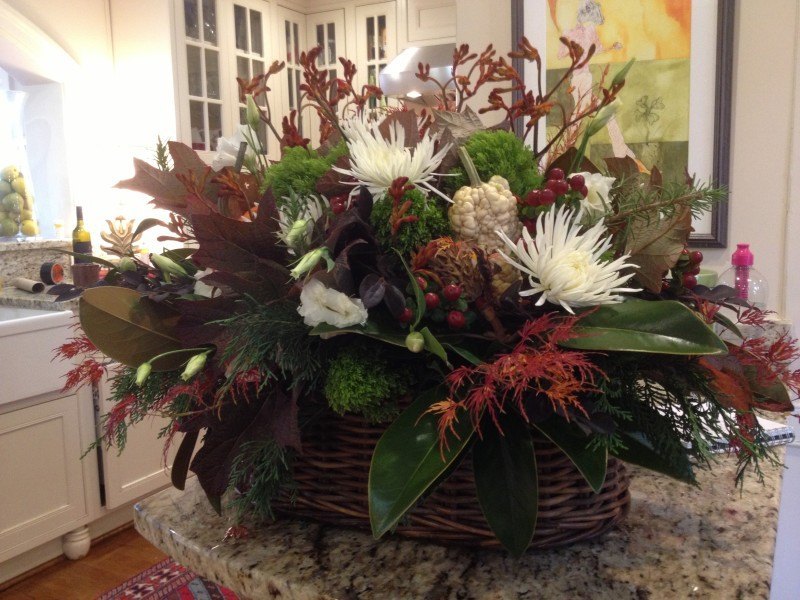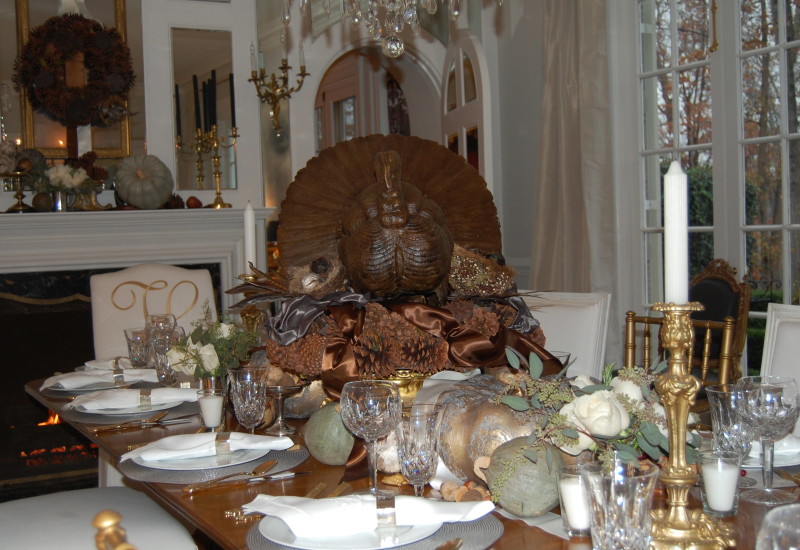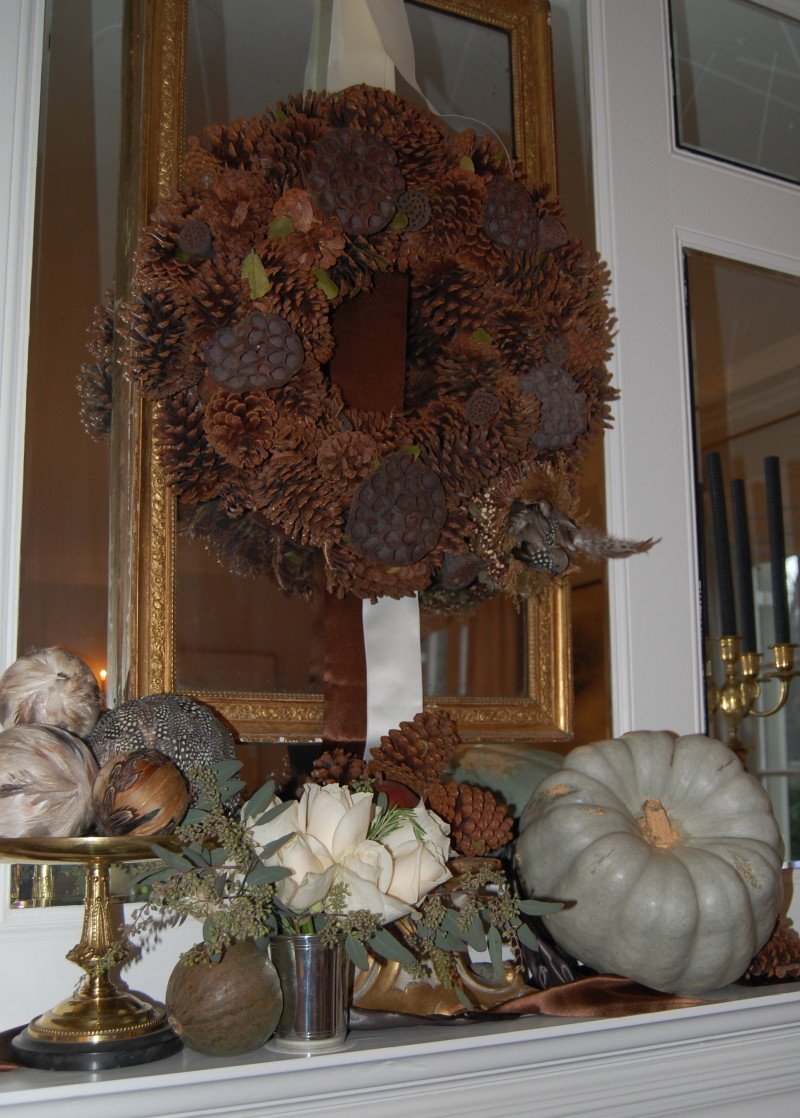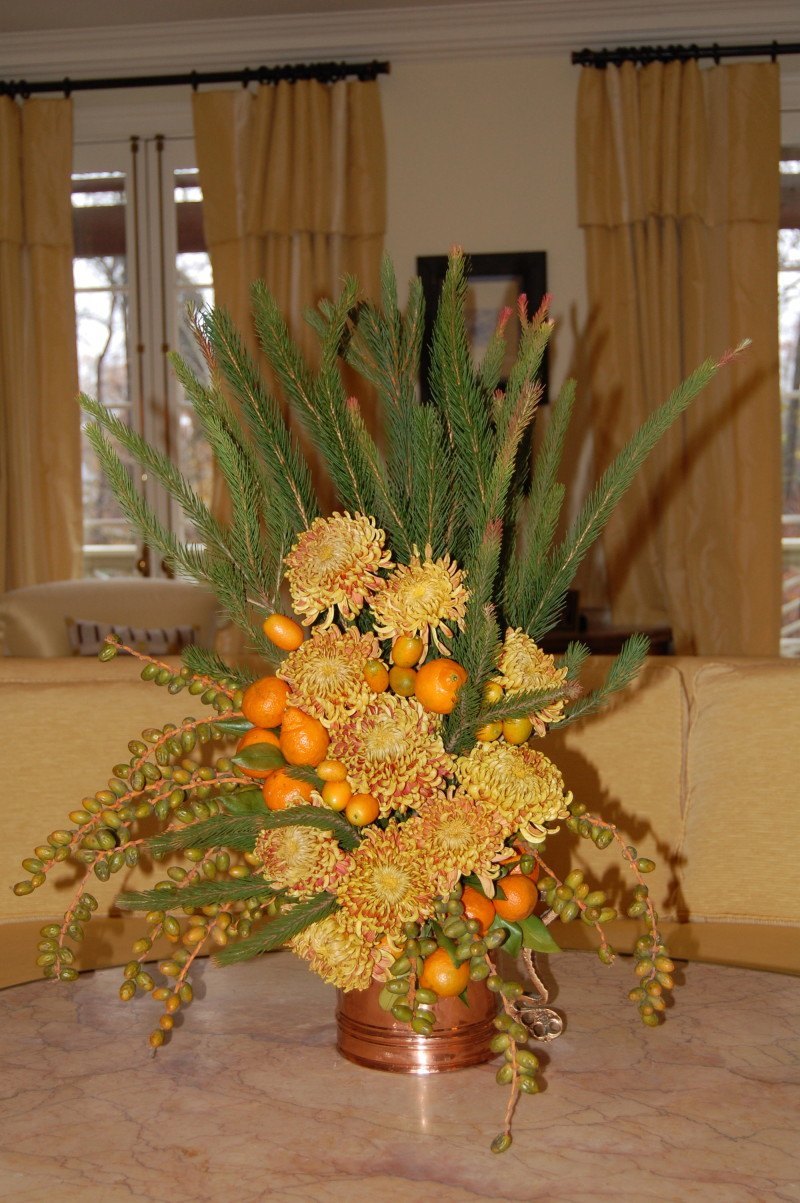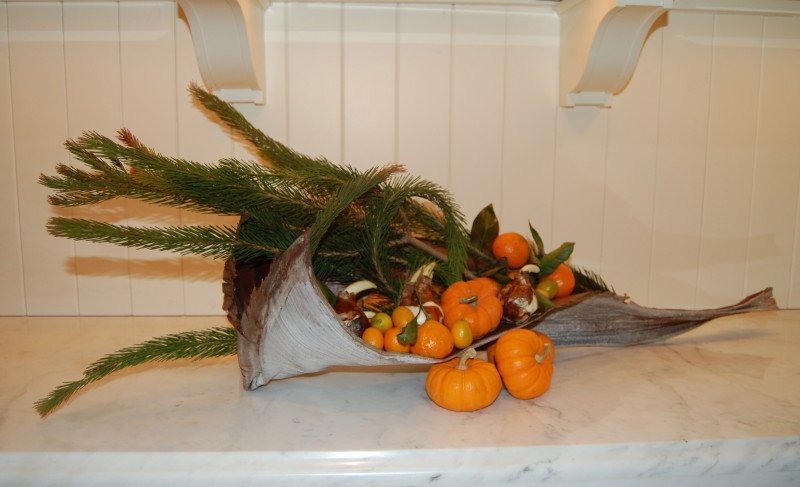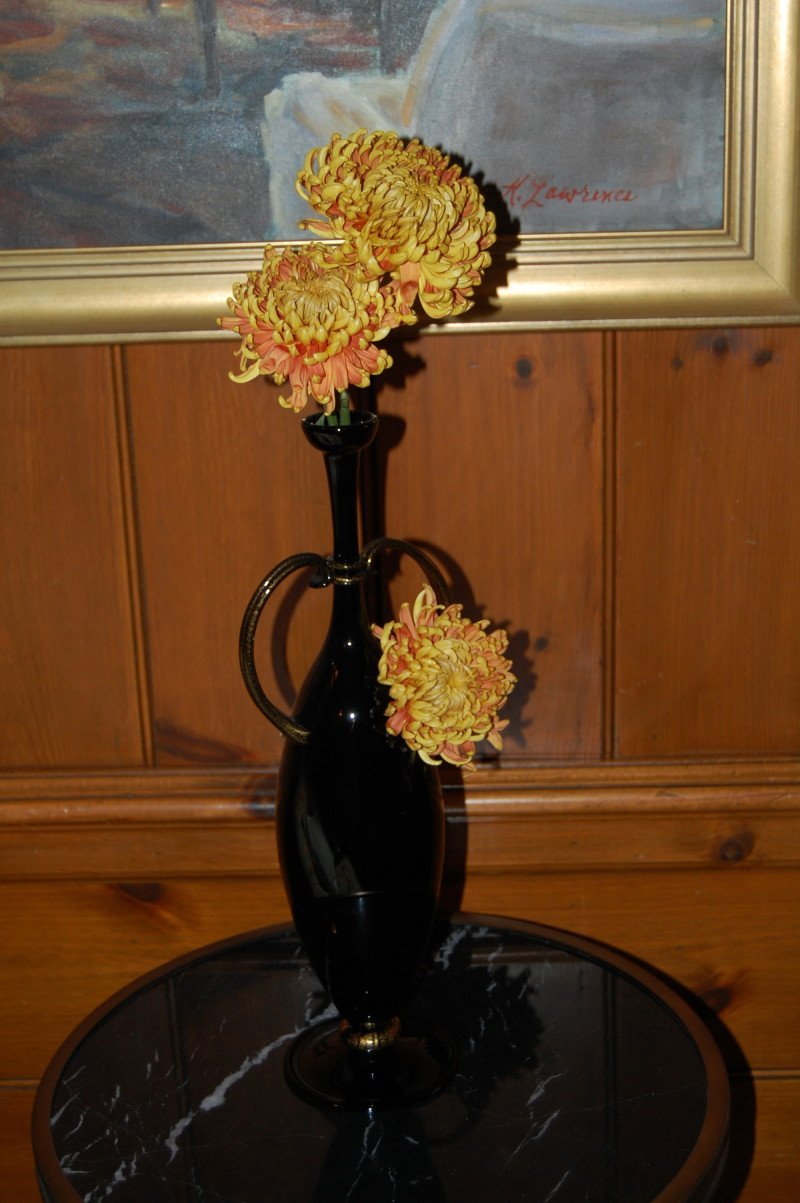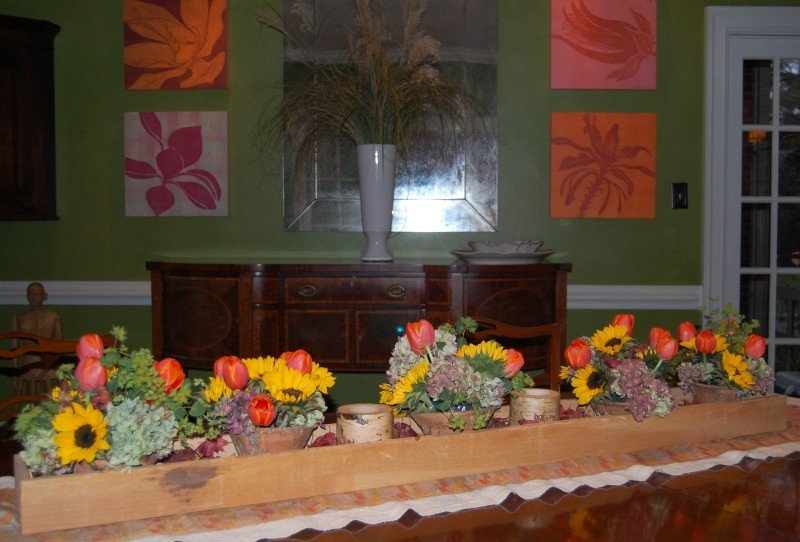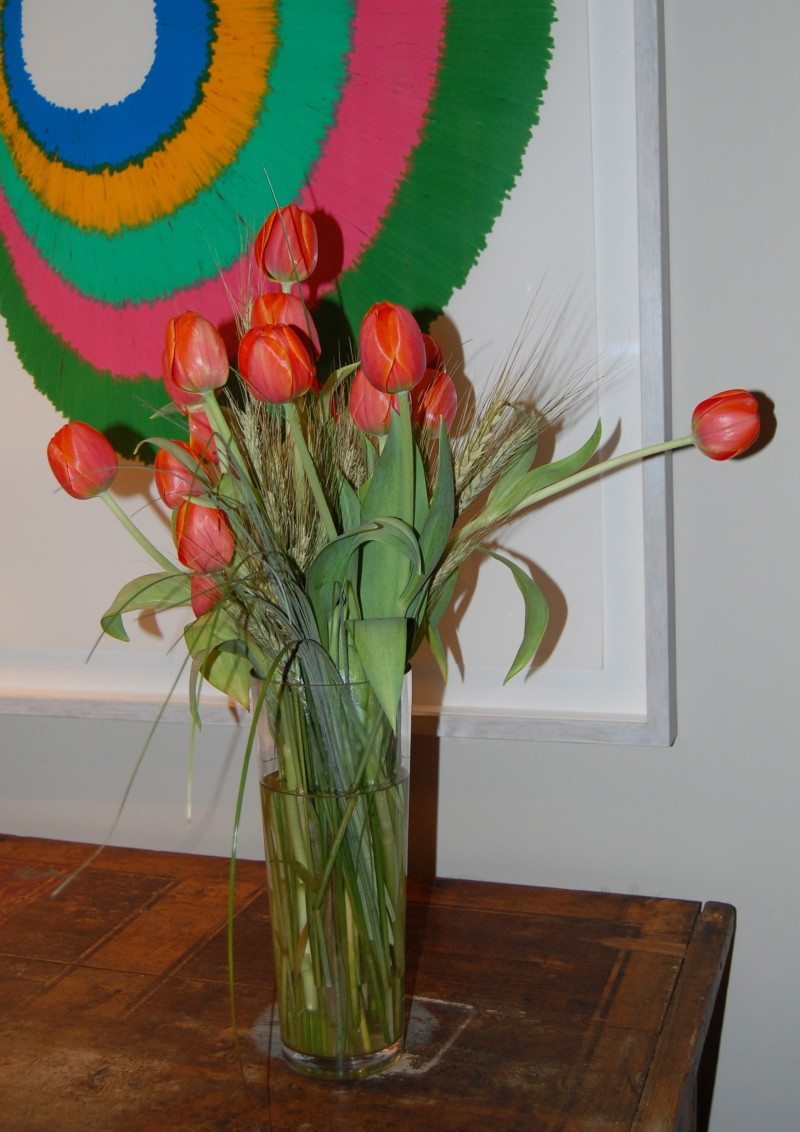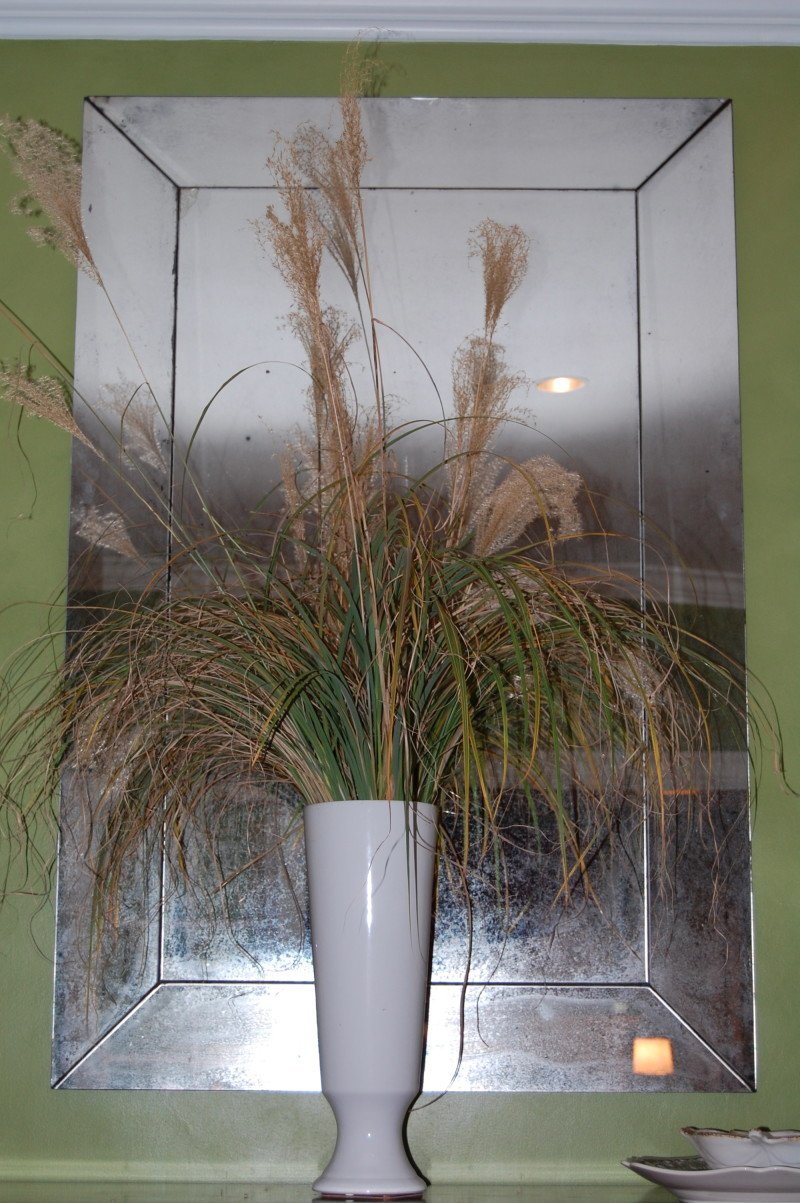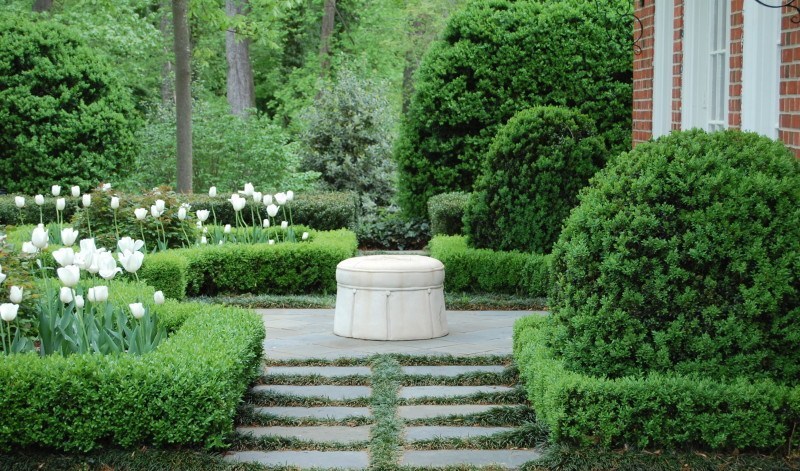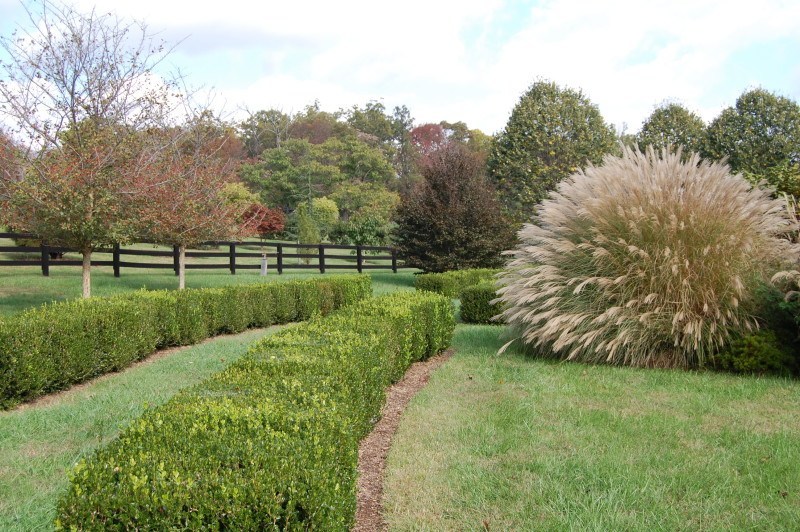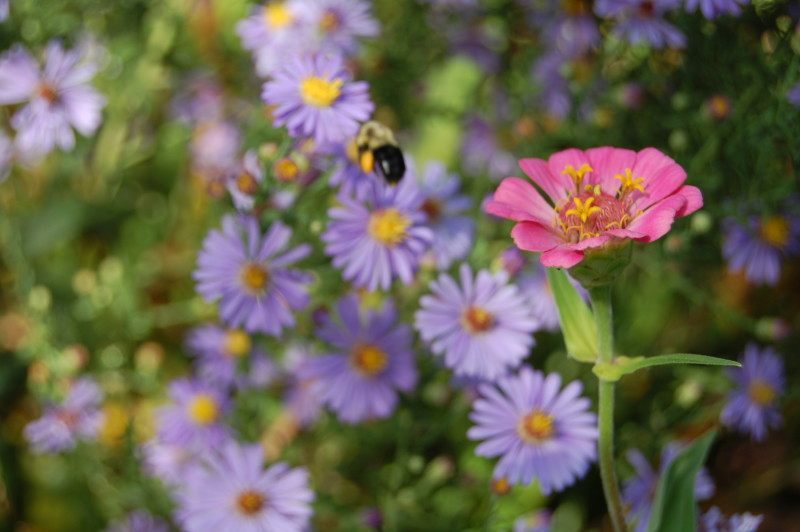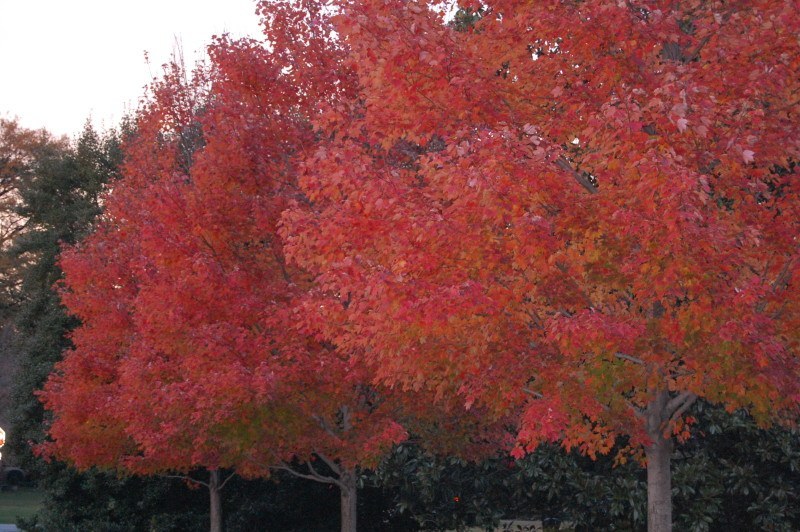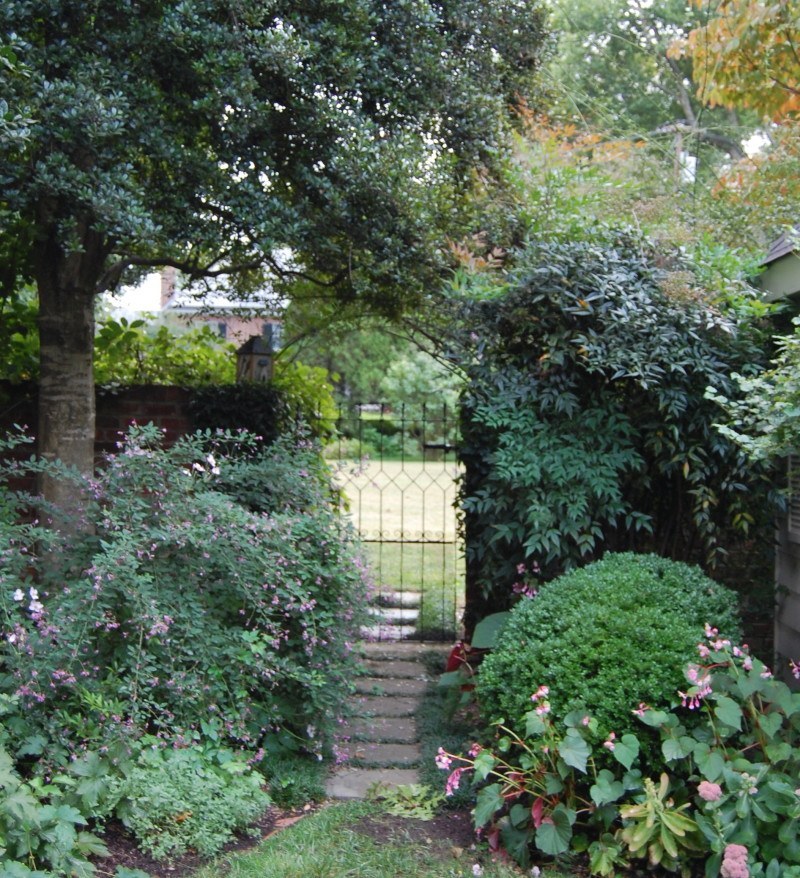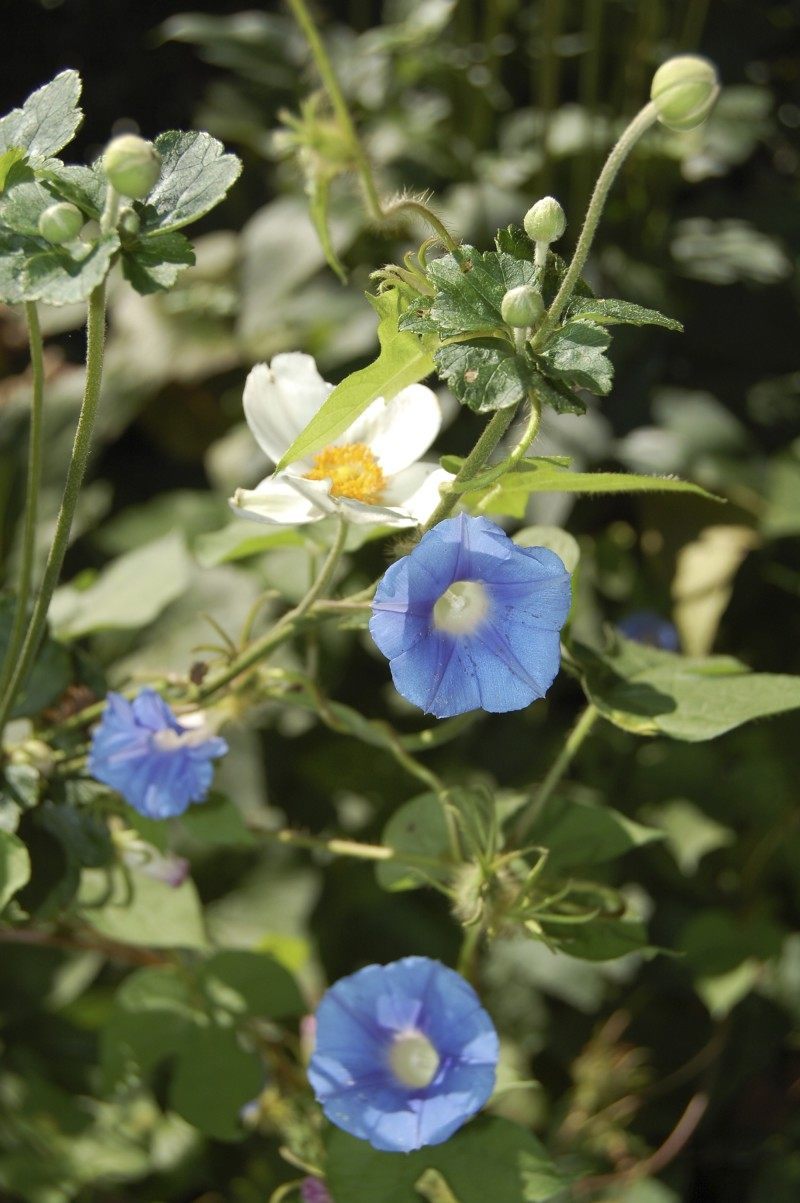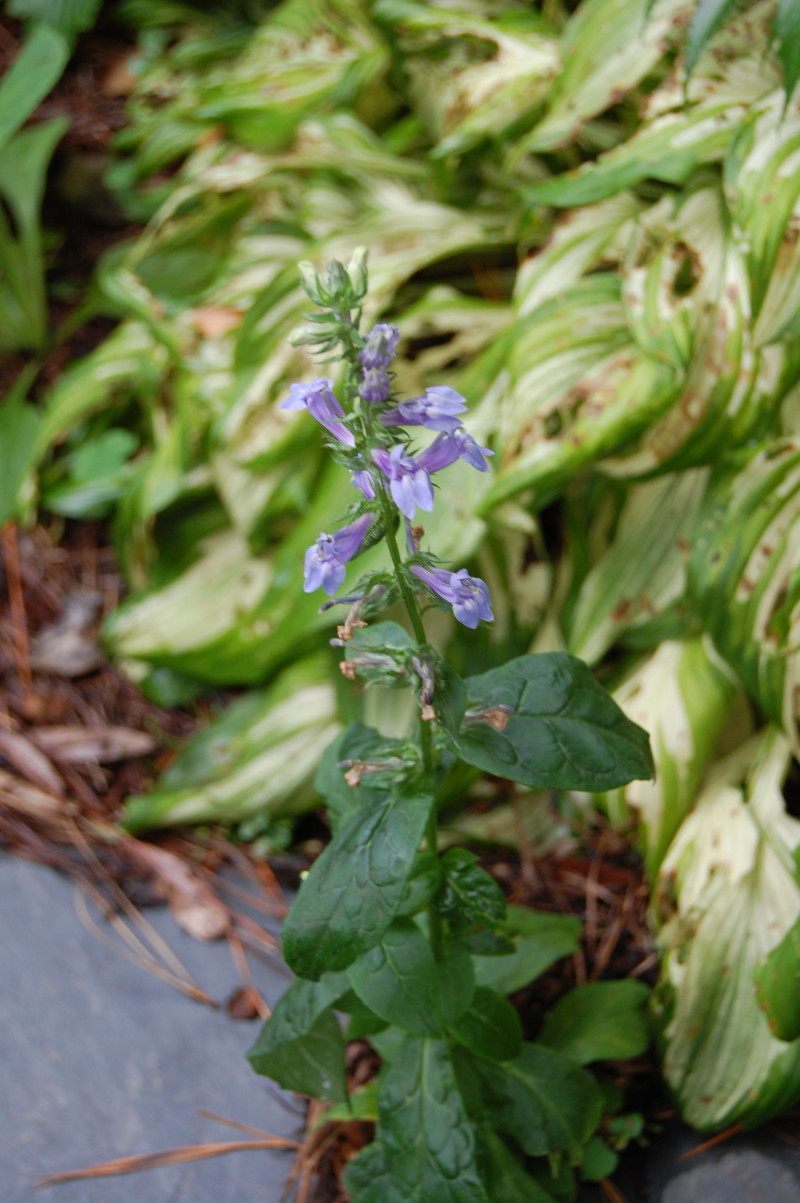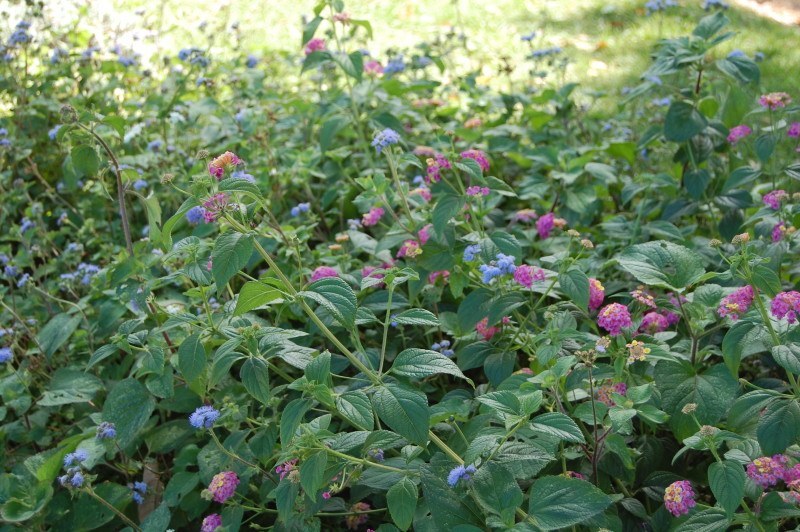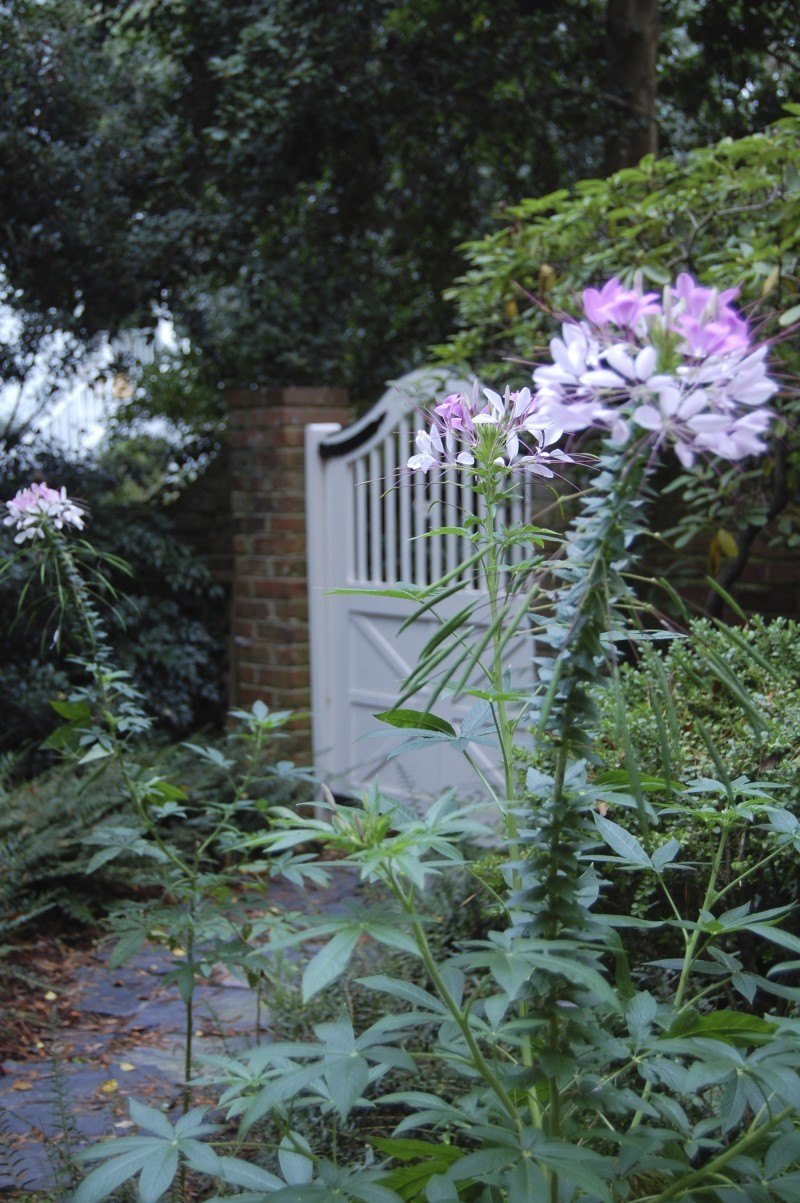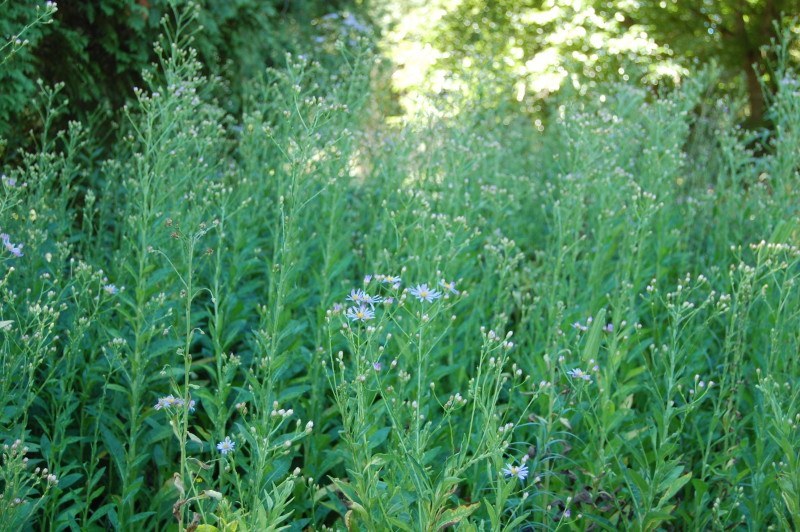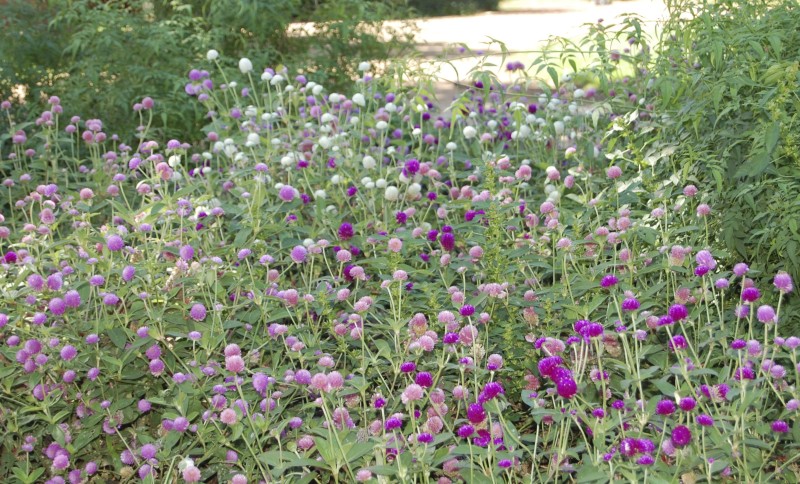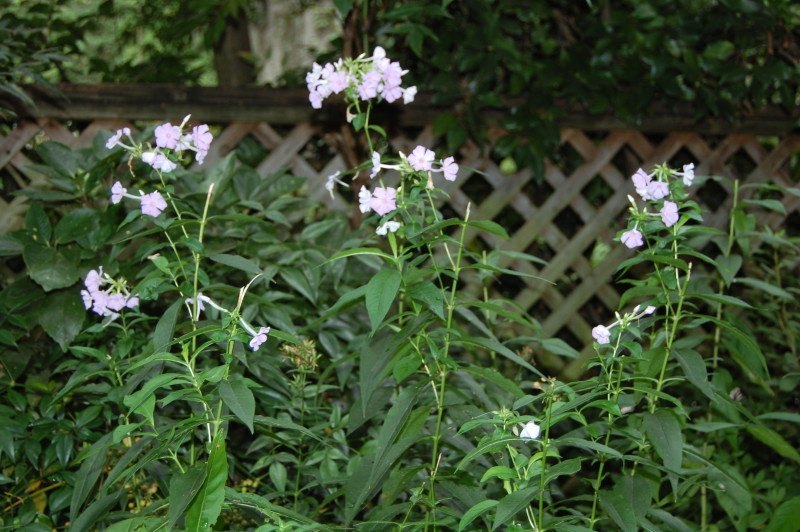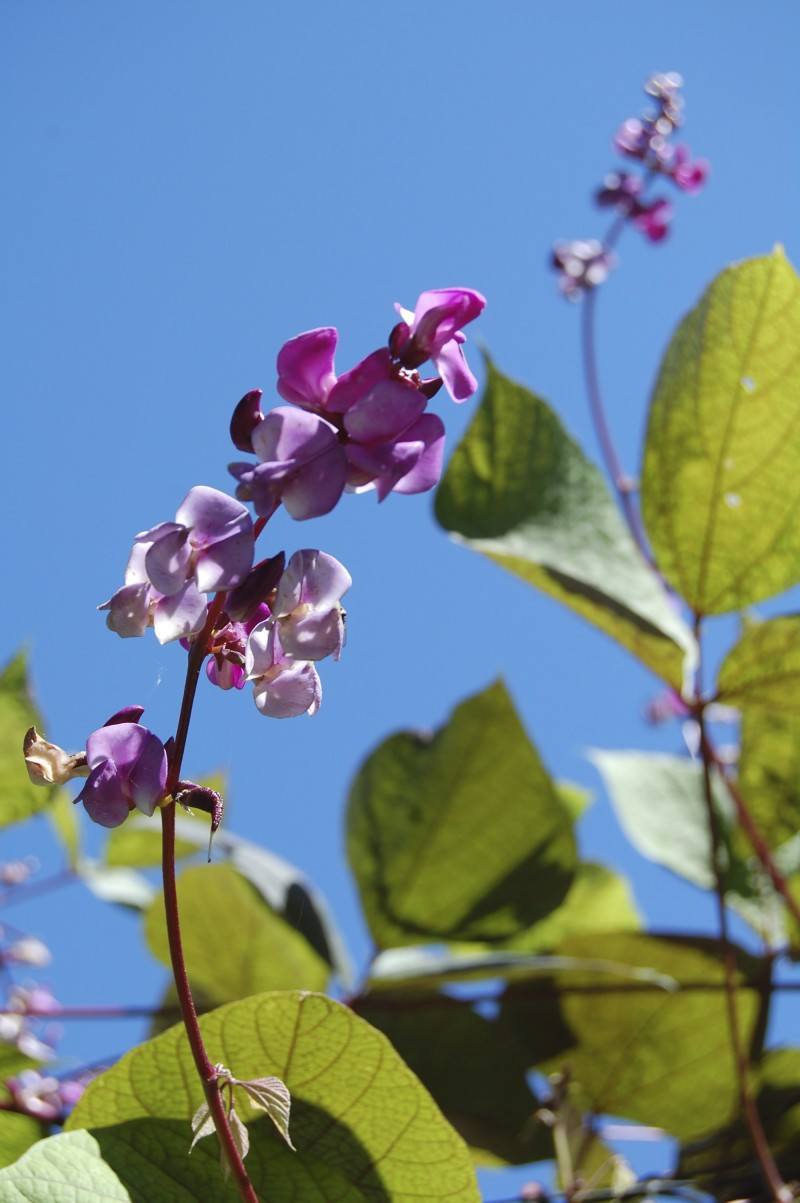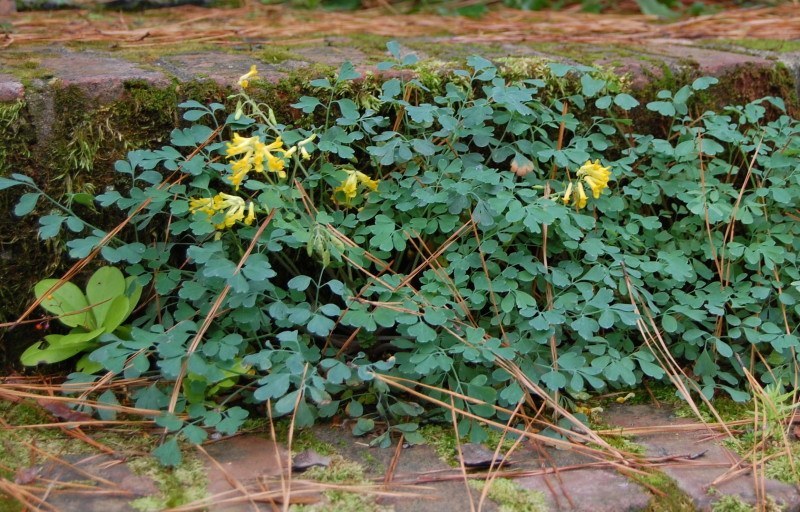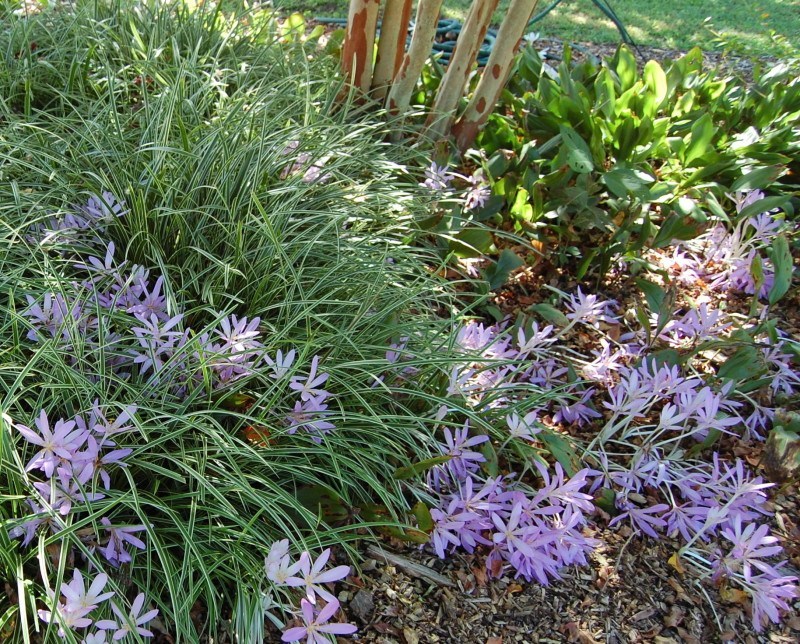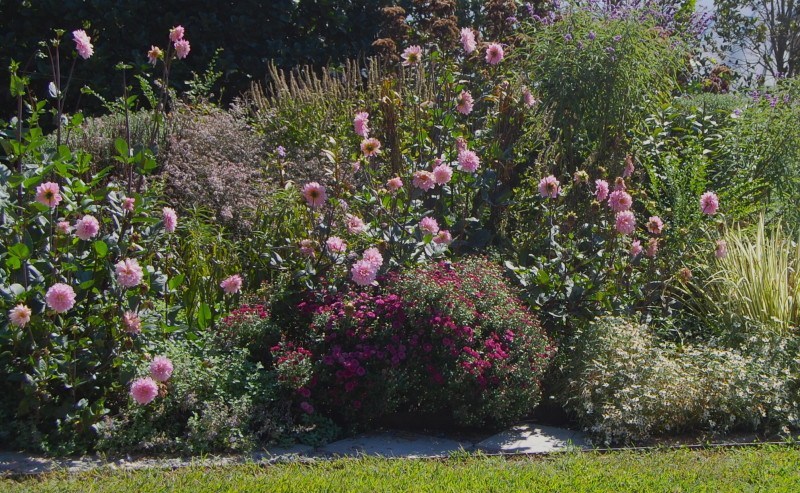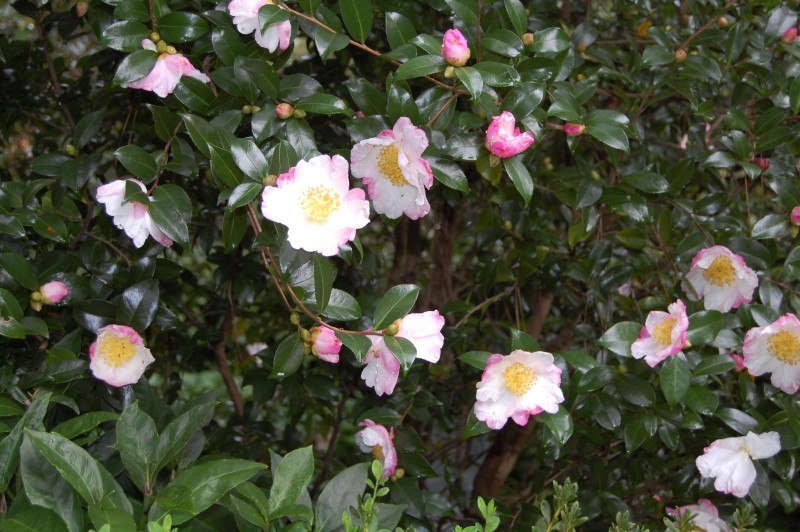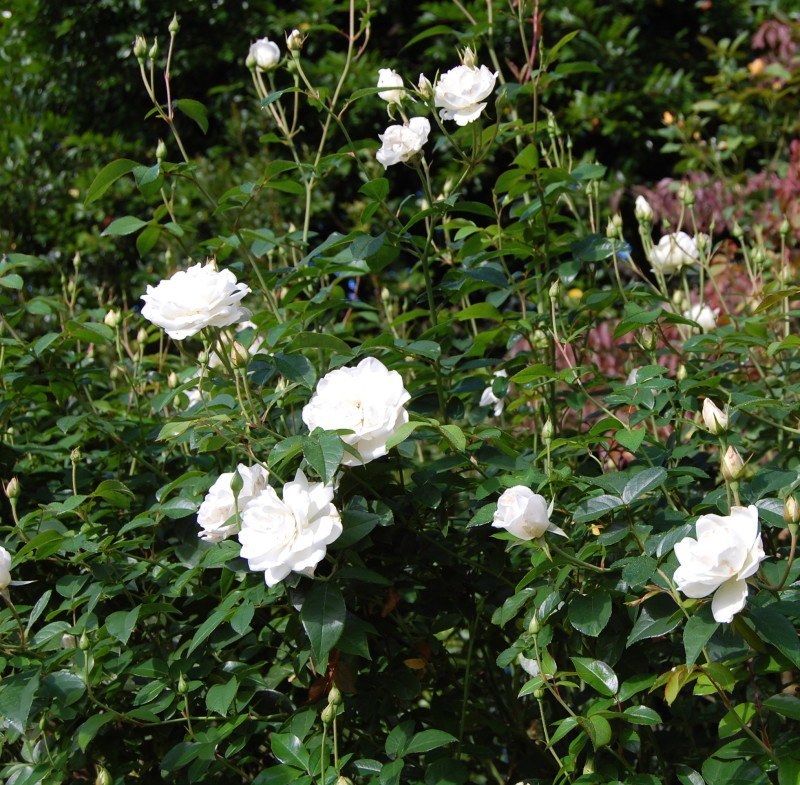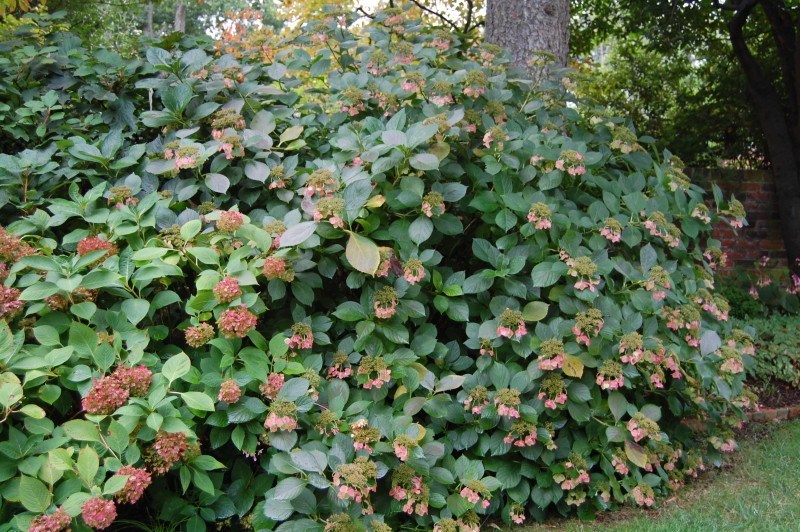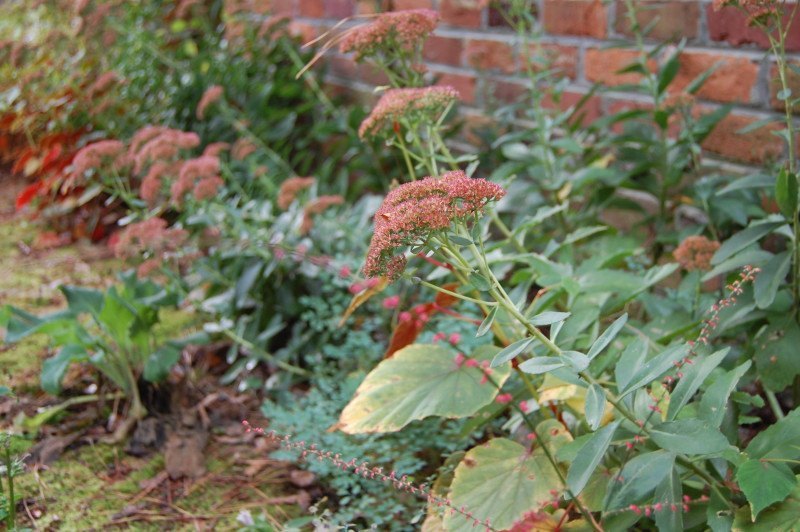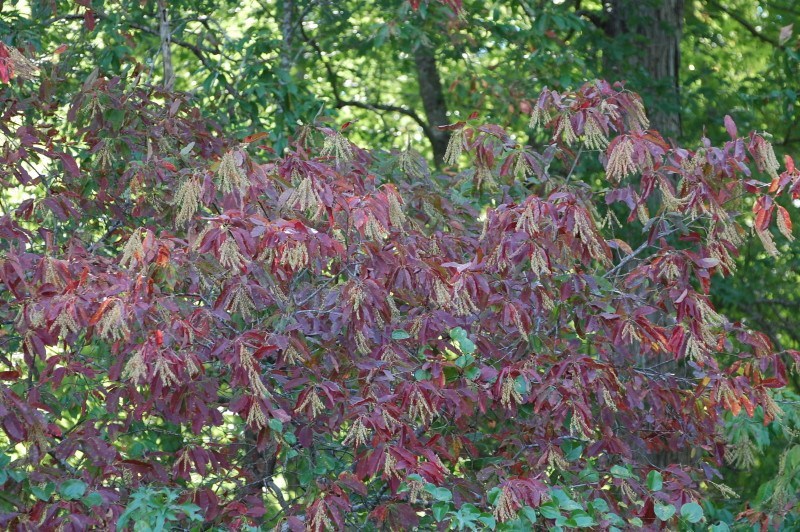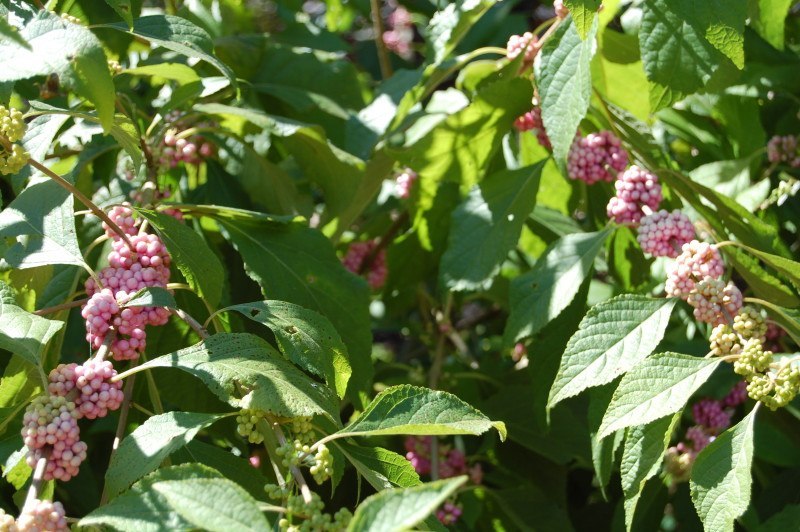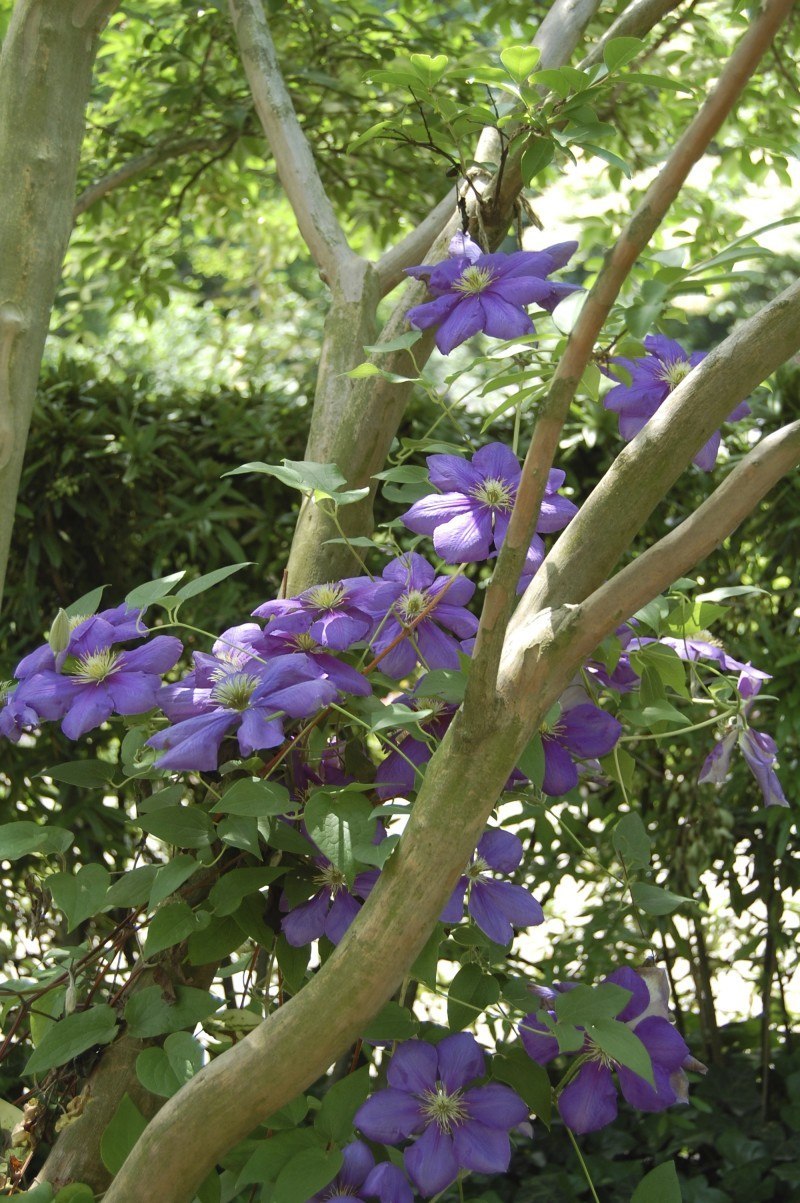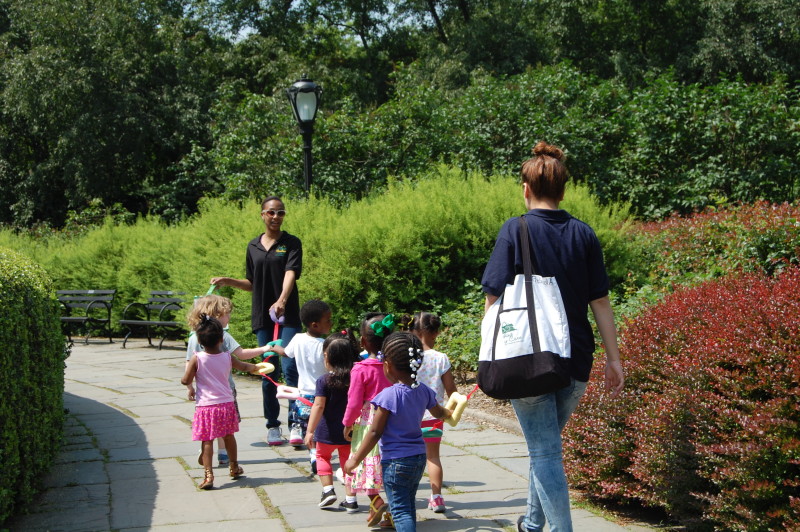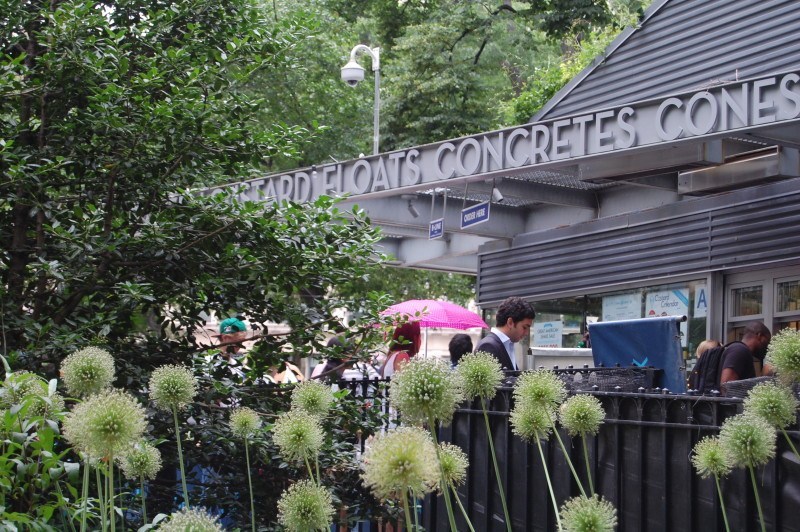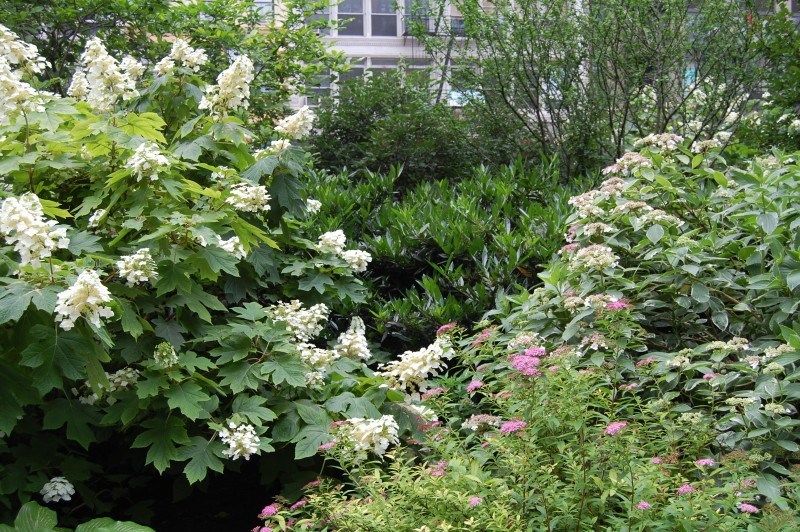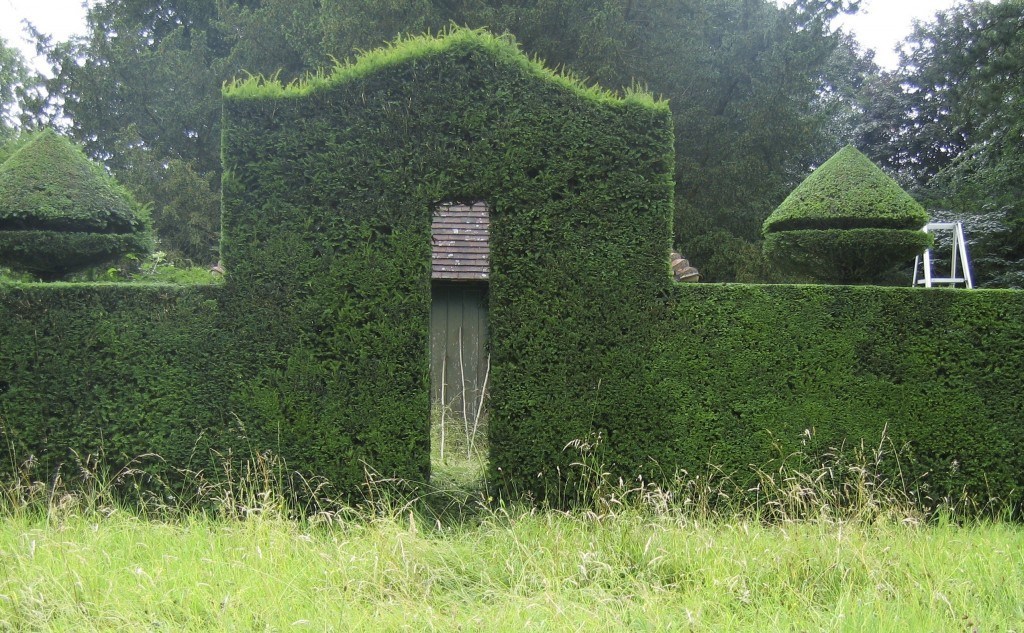GIVING THANKS FOR NATURE’S BOUNTY AND BEAUTY
Richmond’s talented arrangers got creative once again for Thanksgiving. Now that the ugly weather has finally passed through, and the sun is bringing in a glorious day, these arrangements might lure you to take a walk and enjoy — and be thankful for — nature’s beauty, even on a cold November day.
Melinda Hardy supplemented the native Bittersweet with Seeded Eucalyptus, twigs, and even feathers. Rumor has it she plucked that turkey herself.
On her dining room table, Melinda filled three containers with white Roses, Lilies, Rose Hips and more Seeded Eucalyptus and Eucalyptus pods.
Melinda gathered her leftover Eucalyptus pods and created a stark, yet stunning composition.
Melinda filled the test-tube container with the same flowers and fruit, but what a completely different feel it has!
Susan Robertson combined hot colors with the Mums, Carnations and berries, but provided the cool anchor of Rosemary, Ferns, Seeded Eucalyptus and white Roses to allow the warmer colors to shine.
Susan cut some Bittersweet growing on a tree in her neighborhood. The berries and the pumpkins frame the countryside painting so beautifully.
Nan McVey sent this picture to me a couple of weeks ago. Nan’s flair for elegance is on display here, where white Roses and Orchids are reflected on a mirror-topped table.
Ashley Wallace and Jeannie Shutt filled this beautiful, abundant arrangement with the foliage, flowers, berries, branches and gourds of the season, including Magnolia, Japanese Maple, Oakleaf Hydrangea and Deodar Cedar foliage. They spiced it up with Spider Mums, Lisianthus, Hypericum and Kangaroo Paw blooms.
Laura Valentine created a work of art in her dining room, surrounding the Great Bird with a subtle palette of grays, greens, creams and a touch of gold. Pumpkins, gourds, pinecones, white Roses and Seeded Eucalyptus create a sublime tapestry.
Laura gathers the same bounty on the mantle, underneath a wreath made of pine cones and seed pods. I love the cool palette of the pumpkin (yes, it’s real!), the Seeded Eucalyptus and Roses in combination with the rich browns of the pine cones.
A simple bunch of Amaryllis stems greets visitors in Laura’s entrance hall.
Jeanette McKittrick’s arrangement veritably glows. She filled a copper pot with Mums, Clementines, Kumquats and Date Berries. Australian Pine (note the new red growth at the tips) provides a dramatic backdrop.
Jeanette filled the shedded bark of a Palm Tree with the same Australian Pine, Kumquats and Clementines, and added Paperwhite Narcissus bulbs and little Pumpkins to the overflowing cornucopia. Jeanette worked some of the Pine branches to repeat the gentle curve of the Palm bark.
Jeanette used some of her Mums to create a simple, beautiful line arrangement.
The flower power team of Jennifer, Blakely and Charlotte Sisk took their dynamic art collection as inspiration for these Thanksgiving arrangements. They created a colorful, earthy vignette by filling terracotta pots with Sunflowers, dried Hydrangea blooms, Tulips and Euphorbia, then placed them in a long rustic wooden container with candles wrapped in Birch Tree bark.
Tulips and Wheat are happy together.
The dried plumes and leaves of these grasses simply, but dramatically, convey the turn of the seasons. May you and yours take the time this Thanksgiving to drink in, and give thanks for, the beauty and the sustenance that nature brings us each and every day.
BOXWOOD BLIGHT ALERT
When I last reported about Boxwood Blight (Cylindrocladium buxicola) in my blog, the only known infected plants in Virginia had been quarantined in a nursery on the North Carolina border. The nursery industry and the Virginia Department of Agriculture acted immediately to establish best practices to limit the spread of the blight, and the industry, the government and academia have been working to find ways to combat the disease. Unfortunately, these efforts have not succeeding in isolating the disease. Boxwood Blight has now been reported in residential gardens from North Carolina to Rhode Island, and has been confirmed here in Richmond. Studies have also found that Sarcococca (Sweetbox) and Pachysandra terminalis may also be hosts for the Blight.
I’ve found Saunders Brothers Boxwood Nursery to be the most thorough and current resource for both historical and developing information on the Blight. If this is a subject that affects you, please check the Saunders Brothers website and your local extension agency for the latest updates. The American Boxwood Society will hold its annual symposium May 14-16, 2014, and will devote significant time to Boxwood Blight.
THE SYMPTOMS:
- Dark brown spots on leaves, may eventually cover entire leaf
- Black streams on stems that appear to move from bottom of plant to top
- Severe defoliation and dieback
- North Carolina State University has some good images of plants infected with the Blight.
TREATMENT AND PREVENTION
- It is now accepted, based on research in Europe where gardeners have been dealing with the Blight since the mid 1990’s, that Boxwood Blight is not something that will be eradicated or even prevented, but is instead something that we need to learn to live with and manage (as we do with pysillid and leaf miner).
- The United States Department of Agriculture recommends
removing infected twigs, fallen leaves and the topsoil under affected plants because the fungus can persist on fallen leaves and debris.
-
Saunders Brothers recommends ensuring good air flow in and around plants, ample sunshine, and no overhead irrigation. USDA recommends regular fall pruning to thin the branches of English Boxwood (Buxus sempervirens ‘Suffruticosa’) or other tightly growing Boxwood, to provide air circulation, thus making it harder for the fungus to incubate and spread. This is especially important for tightly growing hedges.
- Saunders Brothers also reports that some “fungicides are very effective in controlling the disease, particularly when applied just before a prime infection period, which would be average temperatures in the 60’s to 70’s and complete wetting of the plant for an extended period”. Please contact your trusted landscaper, extension agent or nursery for more specific guidance on this front.
LESS SUSCEPTIBLE CULTIVARS
English Boxwood seems to be the most susceptible Boxwood to the Blight. Saunders Brothers and North Carolina State University are aggressively researching which cultivars of Buxus are most resistant to the Blight. This from Saunders Brothers:
“We continue to work with the researchers at NC State as they do varietal susceptibility trials. This spring we took a second load of plants to begin testing. The good news is that early tests show several of the varieties we have grown for years appear to have very good resistance to Boxwood Blight. ‘Green Beauty’, Insularis ‘Nana’, ‘Golden Dream’, ‘Winter Gem’, ‘Dee Runk’, ‘Fastigiata’, ‘Green Gem’, and ‘John Baldwin’ all show considerable resistance to the disease. ‘Green Mountain’ and ‘Jim Stauffer’ both show some resistance.”
If you think your Boxwood are infected with Boxwood Blight, consult a trusted landscape expert and/or bring a sample (double-bagged) to your local extension office for diagnosis.
FLOWERS FOR THE OCTOBER GARDEN
Yes, October means our Maples, Ginkgos, Black Gums and Sourwoods step out of the background and take center stage. But it’s not all about the foliage in October. Several plants are blooming their heads off this time of year. Here are a few to consider adding to your garden to extend the bloom season into fall.
In Peggy Valentine’s charming garden, Lespedeza thunbergii (also called Pink Bush Clover) spreads its pink wings, while Japanese Anemone (Anemone japonica) climbs through it. In the foreground, Hardy Begonia and Sedum compete for attention. The Begonia pictured was named for Peggy. She allows plants such as the Lespedeza and Begonia to spread sparingly. I’m envious of her ability to balance volunteers in both numbers and species to create a seemingly spontaneous yet dazzling plant palette.
Honorine Jobert Anemone (Anemone japonica ‘Honorine Jobert’) is a great perennial to tuck in the back of most perennial borders. It grows unobtrusively until late summer, when its stem shoots up to about 3 feet, producing single white flowers that bloom profusely until a hard frost. Many gardeners find Morning Glories to be a pest, but I can’t help loving them. The Morning Glories in my yard have become good friends with my Anemones.
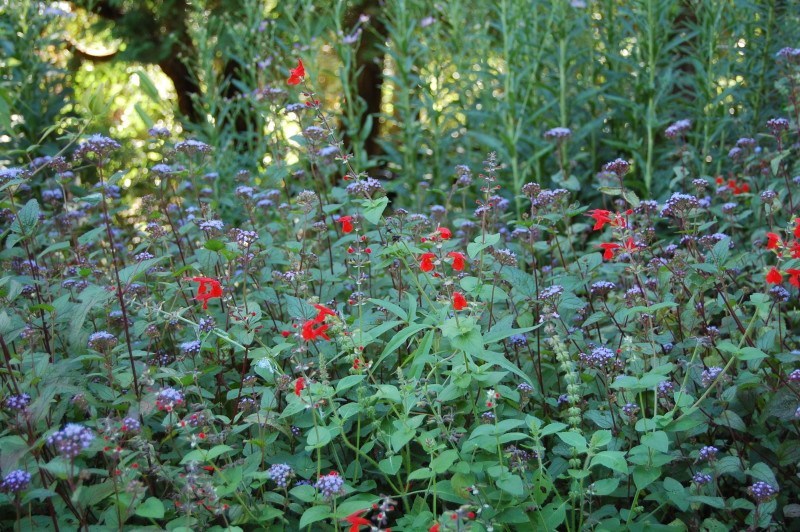 Cardinal Flower (Lobelia cardinalis) and the perennial form of Blue Mistflower (Eupatorium coelistium) happily co-exist in the perennial bed. Plant them with earlier flowering perennials such as Columbine (Aquilegia, spp.) and False Indigo (Baptisia australis). The Eupatorium and the Cardinal Flower are naturally found near stream banks and will grow in damp soils.
Cardinal Flower (Lobelia cardinalis) and the perennial form of Blue Mistflower (Eupatorium coelistium) happily co-exist in the perennial bed. Plant them with earlier flowering perennials such as Columbine (Aquilegia, spp.) and False Indigo (Baptisia australis). The Eupatorium and the Cardinal Flower are naturally found near stream banks and will grow in damp soils.
Great Blue Lobelia (Lobelia siphilitica) is another native Lobelia found in the wild near stream banks. This little guy popped up in the cracks of a garden path.
The annual form of Eupatorium (Ageratum houstonianum) pairs nicely with other annuals, like this Lantana which blooms all summer.
Mary Glen Taylor’s lovingly tended four-season garden is full of fall-blooming flowers. Her Spider Flower (Cleome hassleriana) leads the way to the beautiful garden gate. Cleome is a drought-tolerant self-seeding annual that grows in sun and part shade. If you don’t want it to bloom next year, be sure to cut it back before it sheds its seeds.
I didn’t catch the name of this Aster blooming at Monticello’s Tufton Farm, but it looks like the Michaelmas Daisy, or Monch Aster (Aster x frikartii ‘Monch’). At Tufton Farm, the focus is on plants important to America’s horticultural heritage. Thomas Jefferson was interested in learning about plants native to Virginia, native to other parts of the United States (many of which were brought back by Lewis and Clark) and native to Europe. Tufton propagates plants from all of these places, and supplies Monticello with many of the resulting plants.
Melinda Hardy hijacked my camera to catch this bee hovering around the Asters and Zinnias in garden writer Marty Ross’s expansive Gloucester garden.
Globe Amaranth (Gomphrena globosa — sounds like a communicable disease!) is another late-blooming annual to give color to the fall garden. It grows 12-24 inches. The actual flowers are insignificant — the bracts are the showy part of the plant.
Mary Glen collected this Carolina Phlox (Phlox carolina) in Roaring Gap, North Carolina. Mary Glen says that it reseeds in this pale pink and in a hotter pink, and blooms all summer (and fall).
Collect the seeds of Purple Hyacinth Bean (Lablab purpurea) and plant next spring along a fence for gorgeous late summer and fall blooms.
Corydalis (Corydalis lutea) blooms all summer when happy. It prefers rich, moist soil that never dries out. It is a rampant weed in cool, damp climates, but stays under control in our hot and humid weather.
My Capital Trees buddies and I came upon these Autumn Crocus (Colchicum autumnale) in Brent and Becky Heath’s garden (Brent and Becky’s Bulbs) in Gloucester. Plant these bulbs where perennials such as Bleeding Heart (Dicentra) go dormant in summer.
This exuberant perennial bed in Brent and Becky’s garden is bursting with pink Dahlias. Growing Dahlias is a labor of love In Richmond, because the tubers should be dug up and stored each winter. You might get away with leaving Dahlia tubers in the ground over a mild winter in Zone 7, but you risk harming or killing them if we have a harsh winter (which some predict this year).
Sasanqua Camellias usually bloom for a good two months in fall. This single-flowered Camellia is Hana Jiman.
In Virginia, roses come alive again once the heat retreats. This Iceberg Rose makes a beautiful hedge.
Fading plant blooms give the fall garden a melancholy beauty. Peggy’s garden is filled with Hydrangeas that turn bronzy pink in fall.
The Sedum’s dried flower heads look smashing against Mary Glen’s red brick wall. Reddening Begonia leaves are in the background and the tiny pink blooms of the Jewels of Opar (Talinum paniculatum) are in the foreground.
The fading blossoms of the native Sourwood (Oxydendrum arboretum) are highlighted by the red fall folliage of the tree.
The pink berries of this native American Beautyberry (Callicarpa americana) growing in Marty Ross’s garden are just beginning to ripen. Beautyberry attracts birds and is drought tolerant. Plant it behind a low evergreen shrub or dwarf Butterfly Bush (Buddleia davidii). Cut it back generously in late winter or early spring to keep it from getting too gangly.
The air is crisp. The earth is still warm. There’s no better time to dig in the garden.
CENTRAL PARK’S CONSERVATORY GARDEN IS A MODEL FOR RICHMOND
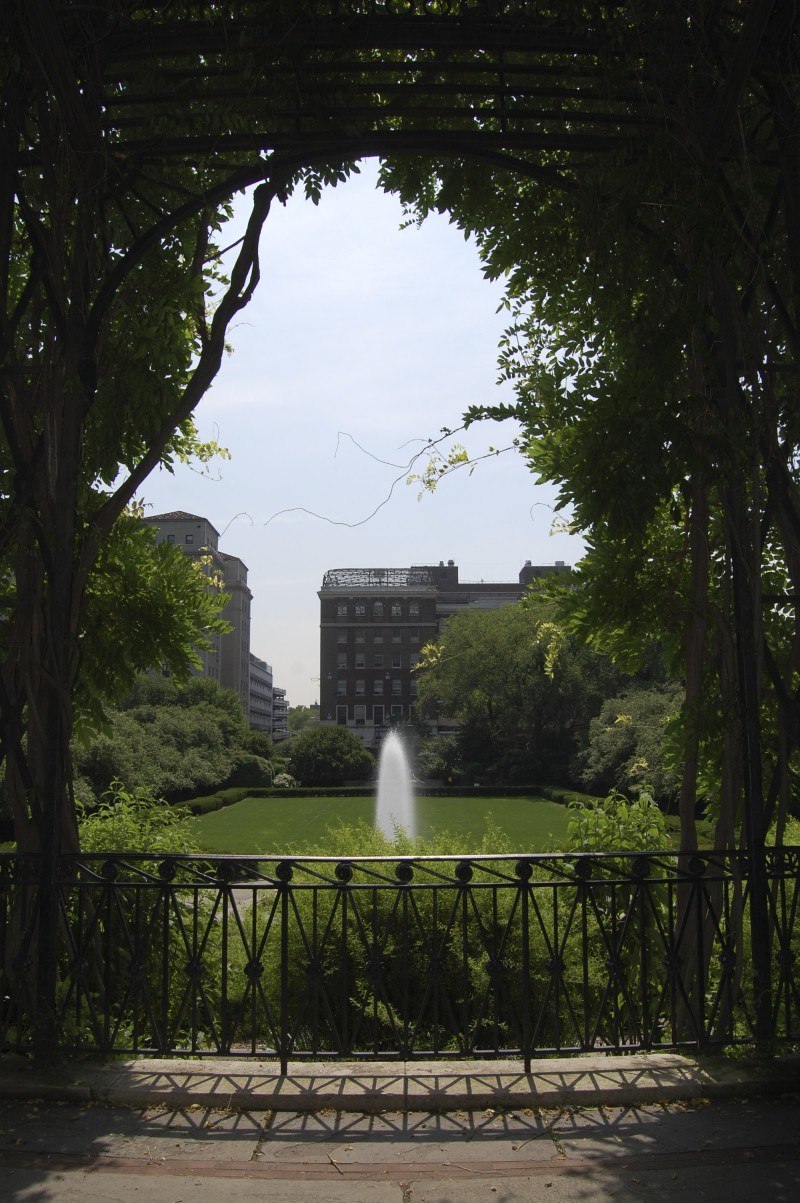
Central Park’s Conservatory Garden in East Harlem (named for the conservatory that inhabited the space from 1899 to 1934) was restored to its former glory, thanks in large part to the vision and tenacity of Lynden Miller. Her work to transform the crime-ridden, overgrown eyesore at the north end of Central Park was so successful that she moved on to restore many other public parks.
Richmond is undergoing an exciting transformation. Richmond legend Mike Hughes wrote a moving and motivational column about it recently in the Richmond Times Dispatch. Artists are transforming Broad Street into an arts district; the design industry is turning Shockoe Bottom into a design destination; outdoor enthusiasts continue to revitalize the riverfront. Capital Trees, a non-profit organization near and dear to my heart, is working with many civic, professional and business partners to support and accelerate this renaissance by tapping into the enormous potential of our parks and other public spaces, with the goal of making them beautiful, inviting and functional urban landscapes.
I blogged a few months ago about New York public garden designer Lynden Miller’s visit to Richmond in January at the invitation of Capital Trees and Lewis Ginter Botanical Garden. She galvanized her audience to dream big and join in the revitalization work already underway.
On a cold rainy winter day, Lynden toured some of Capital Trees’ greening projects at various levels of inspiration and completion. We also proudly showed her our beautiful and vast city parks. At every turn, Lynden asked, where are the gardens?
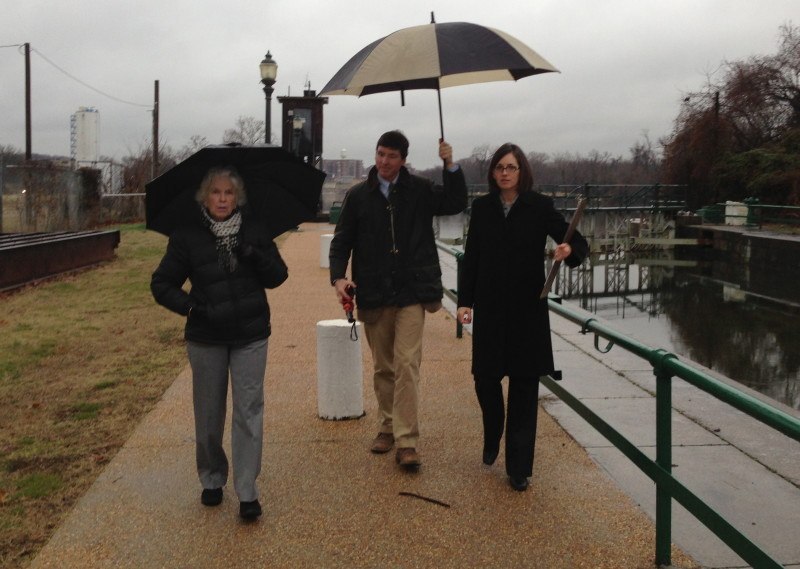
Scott Ukrop and Jill Nolt of 3north show Lynden the plans Jill drafted for renovation of Great Shiplock Park.
She invited me to visit her in New York City to tour the public gardens she has restored, believing those projects would hold lessons for us as we roll up our sleeves in Richmond.
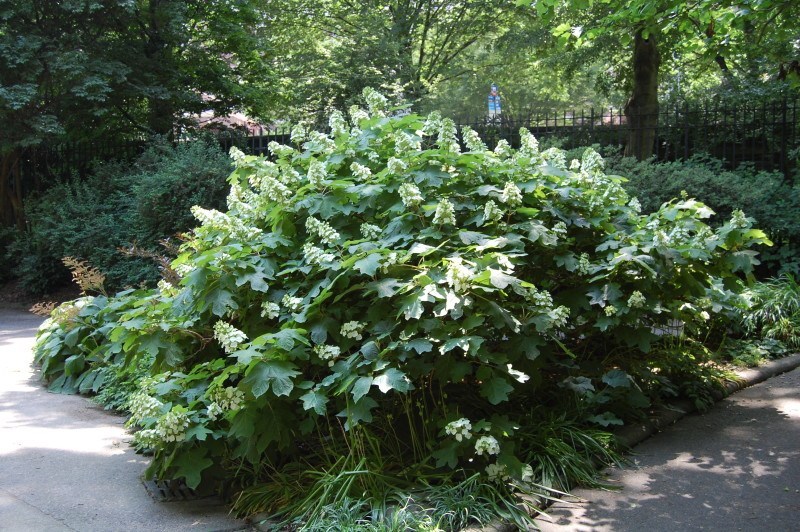
Oakleaf Hydrangea (Hydrangea quercifolia) is Lynden’s signature plant. She uses it liberally in her gardens. Its spring and summer blooms, brilliant fall foliage and exfoliating bark give it year-round interest.
Wow, what an opportunity! I called Ashley Wallace — always up for an adventure — and we road-tripped to Manhattan in June. We met Lynden in the Central Park Conservatory Garden’s North Garden, where we found her hard at work with her committed volunteers.
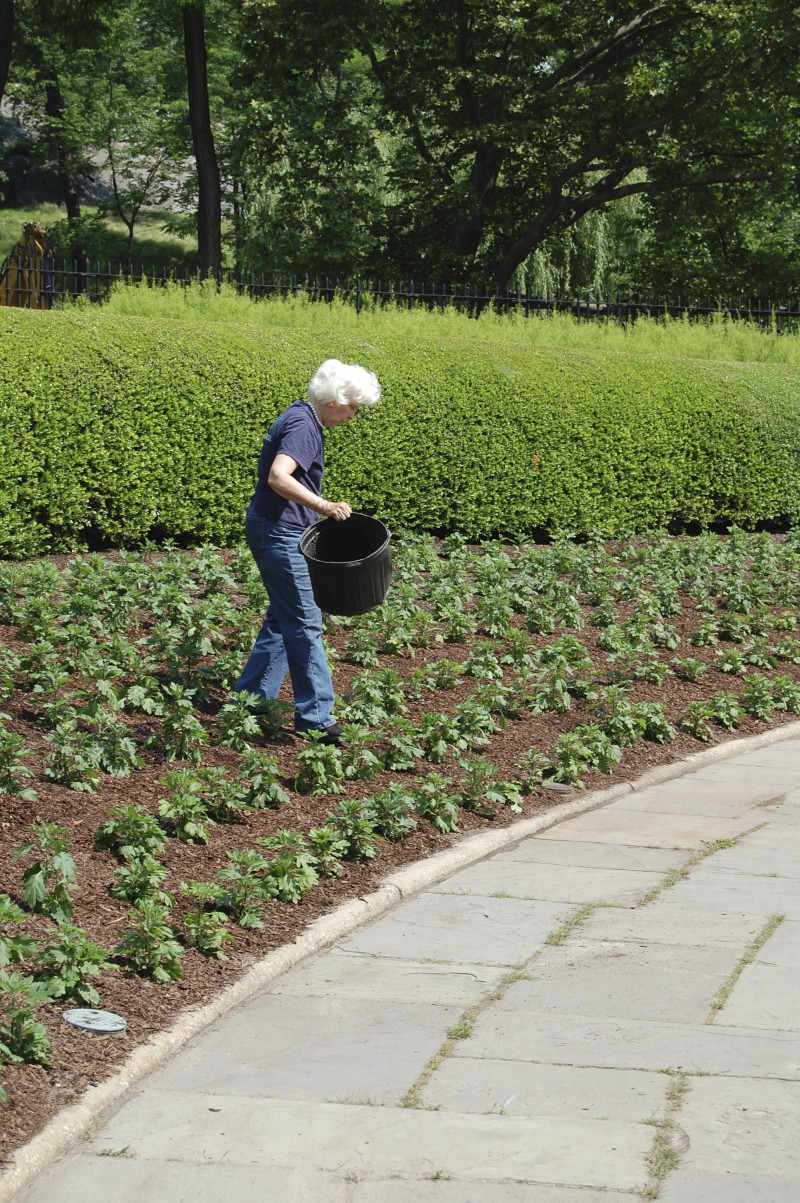
Lynden and the volunteers plant the Conservatory Garden’s North Garden borders with thousands of Korean Chrysanthemums. The Chrysanthemums were first planted in the garden in 1943, and are still propagated — now by the New York Botanical Garden — using a color selection program that yields the masterful blend of colors on display in October.
This post has the twin goals of showing off the beautiful public spaces restored by Lynden and sharing Lynden’s advice — amassed through years of working in the trenches — for how Richmond can succeed in making (and keeping) our public spaces just as beautiful and beloved by our community.
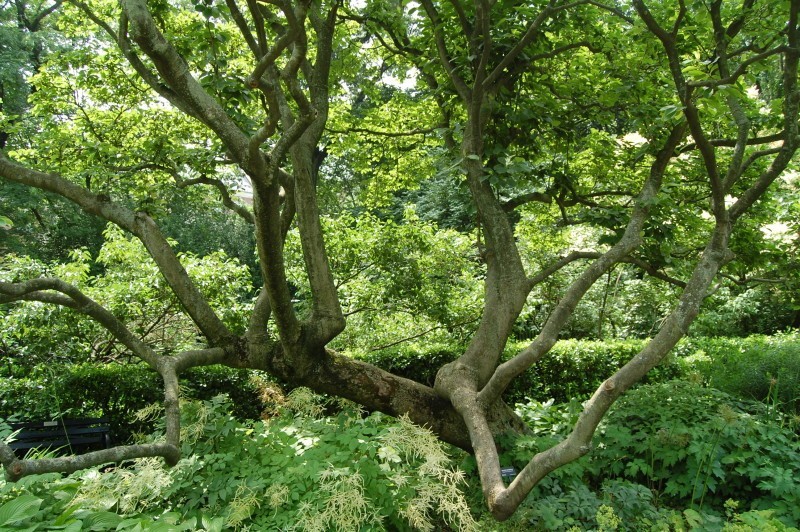
This Magnolia Soulangeana (Saucer Magnolia) is original to the Conservatory Garden, which opened in 1937. The garden was designed by Betty Sprout and Gilmore Clarke. In contrast to the naturalistic style of the rest of Central Park (designed by Frederick Law Olmstead and Calvert Vaux in 1857), the Conservatory Garden reflected the formal design principles of Europe’s renaissance gardens.
FIRST PRINCIPLE: A BEAUTIFUL PARK IS A SAFE PARK
Lynden’s mentor was urban planner William Hollingsworth (Holly) Whyte, who extensively studied how people use public spaces. He counseled Lynden that making parks attractive to as many people as possible drives away criminals. In her book, Parks, Plants and People, Lynden cites a German study that found that the safest places in cities are beautiful outdoor spaces that are well planted and well maintained. This is, of course, common sense, but it is usually not a high priority for cash-strapped cities.
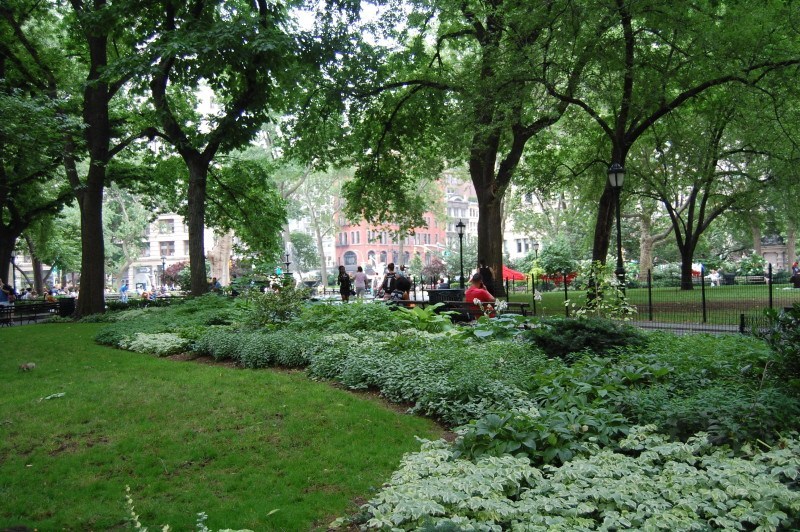
Madison Square Park has become the centerpiece of the Flatiron District. Danny Meyer, owner of Union Square Cafe, sought out Lynden Miller to help revitalize the park, knowing that a beautiful park would attract lots of people, who would in turn attract and support thriving businesses. If you visit Madison Square Park, be sure to grab a sandwich at Mario Batali’s Eataly and bring it back to the park for a picnic, as we did.
Whyte also insisted that a park will only feel safe if the view into and out of the park is not blocked. Lynden put this principle to work in the parks she restored by pruning overgrown hedges and using “see through” wrought iron fences to invite people in while giving the parks a sense of enclosure and definition.
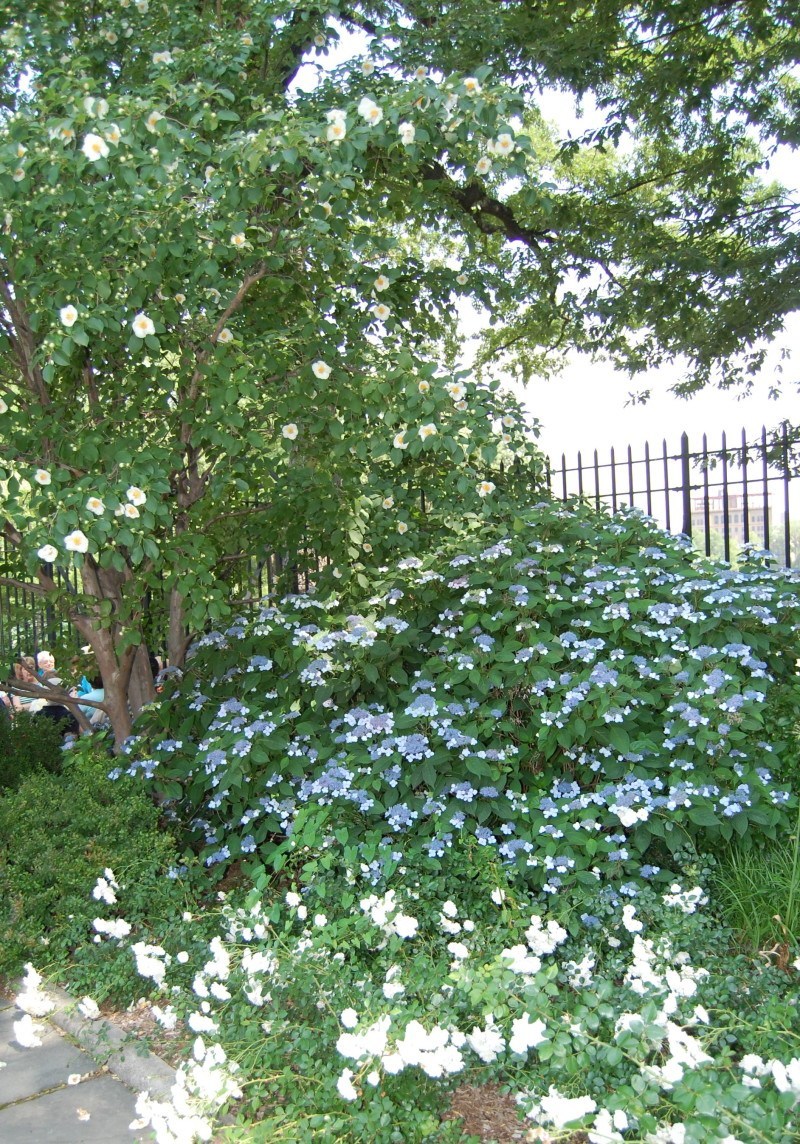
In the Conservatory Garden, the Stewartia pseudocamellia is underplanted with Lacecap Hydrangea (Hydrangea macrophylla) and Shrub Roses (Rosa, spp.). In the background is a wrought iron fence, allowing passers-by on the street to see the gardens.
- Regular maintenance has the same effect. Professional gardeners and committed groups of volunteers, who wear t-shirts identifying them as such, are fixtures at Madison Square Park and the Conservatory Garden. Their day-to-day presence drives out crime.
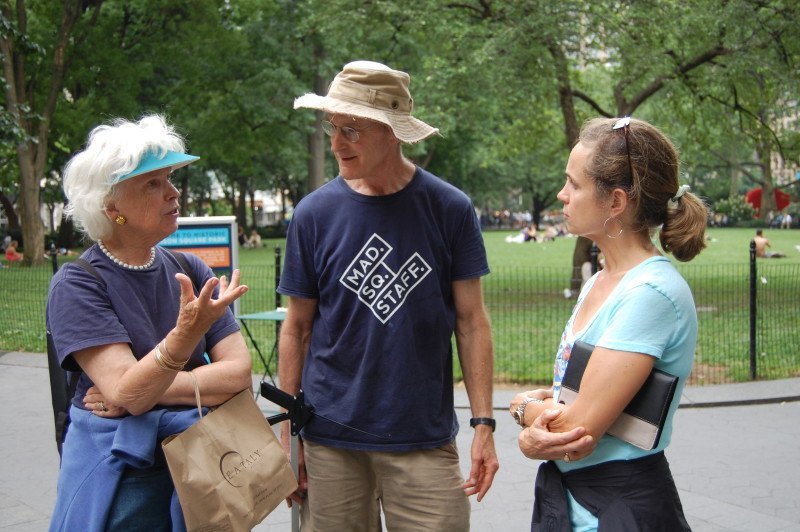
This member of the Madison Square Staff also gardens at Strawberry Fields, the memorial to John Lennon in Central Park.
Before its restoration, the walls and steps leading up to the Conservatory Garden’s pergola were covered in graffiti. The Central Park Conservancy removes graffiti within 24 hours of finding it. This practice has led to a decrease in vandalism in the park.
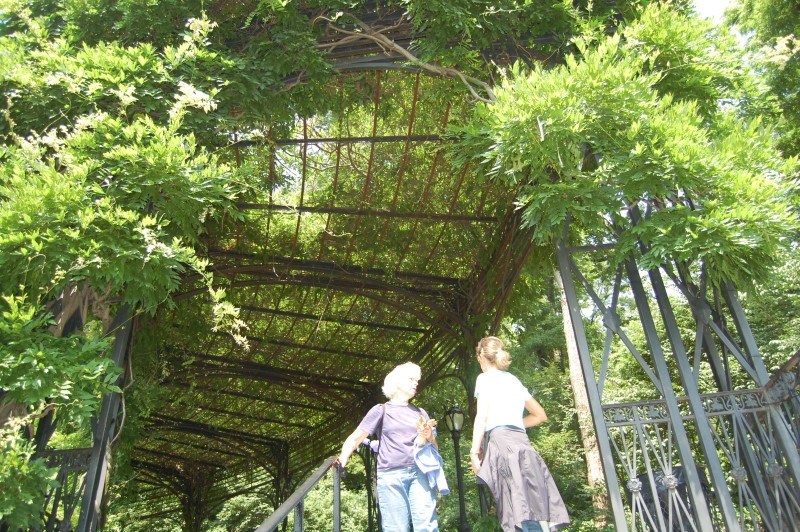
Ashley and Lynden stand under the Conservatory Garden’s iron pergola. Wisteria winds through the pergola, creating a spectacular display in spring directly across from the North Garden’s Vanderbilt Gate entrance.
SECOND PRINCIPLE: FILL THE PARK WITH PLANTS
Urban planners often leave out one crucial ingredient to a successful public space: an abundance of lush plantings. Whether the omission is an aesthetic choice or a more practical decision grounded in an understandable concern about long-term maintenance of a garden, it occurs on a regular basis.
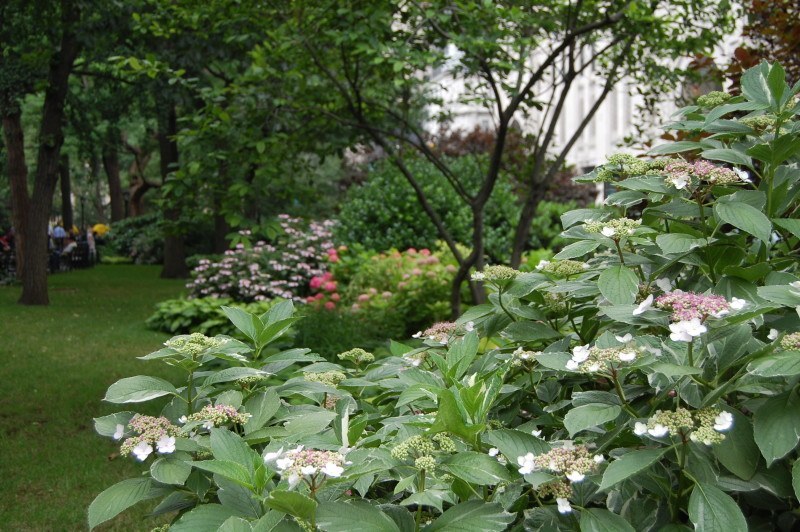
Hydrangea, including this Lacecap, form dramatic sweeps in the vast shrub beds bordering Madison Square Park.
Before meeting Lynden, Holly Whyte did not consider plants to be one of the crucial elements of a successful public park. But after witnessing the plantings Lynden installed in her public commissions, he agreed that they are indeed integral. “As he looked out over thousands of flowers blooming, mothers sitting with their babies, lovers strolling, office workers having lunch, and school groups passing through, . . . he said, ‘I should have thought of horticulture when I made my list of elements for successful urban places. You must make it part of the mix from now on.'”

The Madison Square Park Conservancy presents contemporary art exhibits in the park. Here, pink Astilbe pops with artist Orly Grenger’s bright blue nautical rope installation in the background.
Intrinsic to the horticultural principle is the importance of increasing the urban tree canopy and incorporating beautiful moisture-tolerant plants to absorb storm water. In every Richmond project, Capital Trees advocates planting site-appropriate trees and capturing stormwater in lushly planted rain gardens, thus protecting our beloved James River from harmful runoff.
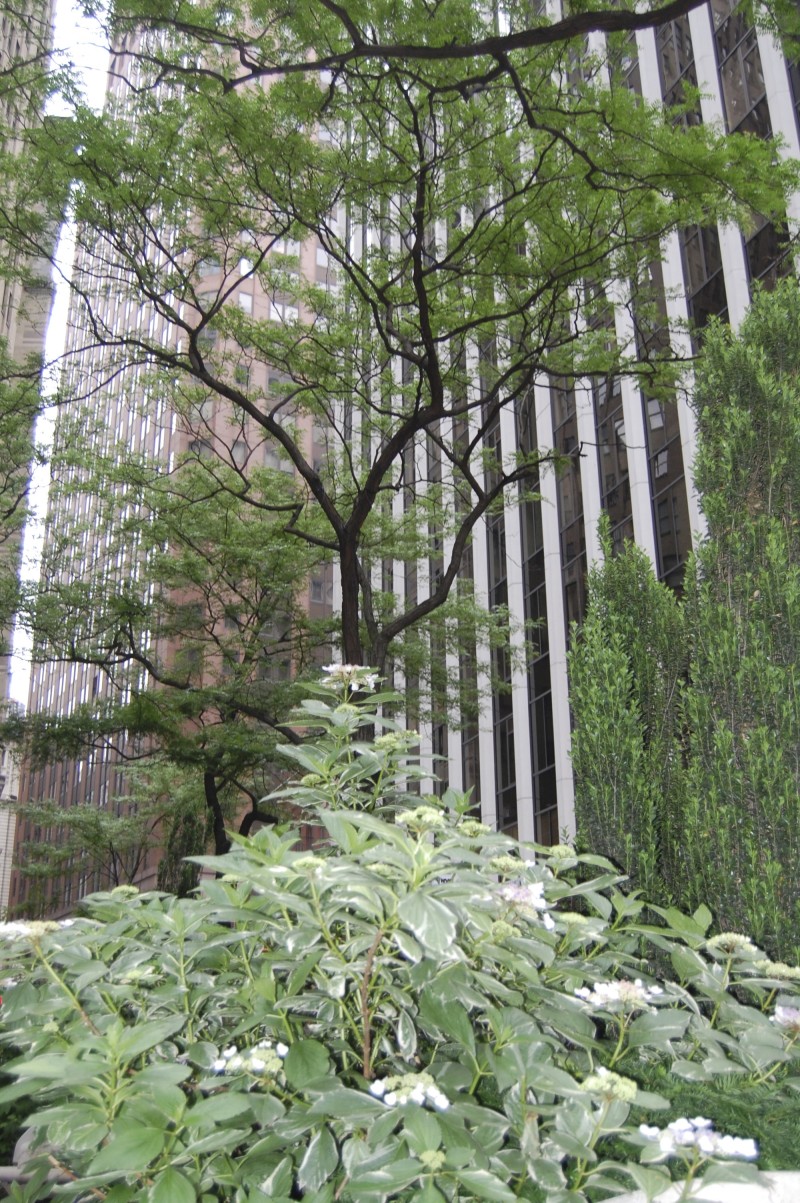
Pocket parks like the Queen Elizabeth II September 11 Garden are a welcome refuge from the surrounding steel towers. This garden memorializes the British citizens who lost their lives in the September 11 terrorist attacks. Lynden collaborated with British Landscape Architects on the plant design.
THIRD PRINCIPLE: GIVE THE PEOPLE WHAT THEY WANT (AND A SENSE OF OWNERSHIP)
Lynden stresses that the most successful public parks are designed after consulting with the people who will use them. Many city parks sit abandoned and covered with graffiti because they do not offer amenities important to the surrounding neighborhoods.
Case in point: The 97th Street Pocket Park. Long ignored because of its location north of the tony portion of Park Avenue, the 97th Street Pocket Park (affectionately referred to as the DMZ before its restoration) was finally given funding for a renovation after neighbors lobbied the city. 97th Street is the only park Lynden restored that does not include a maintenance budget. She relies on volunteers to keep the park healthy and beautiful, and they do, because they fought for it and have a stake in it.
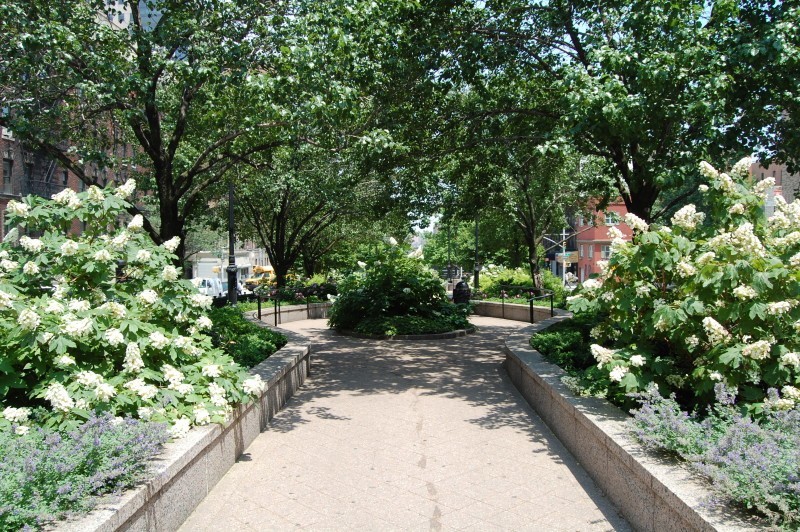
For years, the city placed Chirstmas trees along Park Avenue, stopping short of the park at 96th Street, thus giving residents in Lynden’s neighborhood the message that they were not important. Lynden threatened that she would not work on the park unless the city continued the trees to the park. They complied.
Richmond has had mixed success in addressing its residents’ needs and wants for its parks. The Monroe Park Conservancy has been working with VCU and the City for 10 years to develop a plan that will appeal to students’ everyday use and to groups seeking to hold events, while respecting the park’s history as being welcome to those in need. When building new trails on Chapel Island, James River Parks manager Nathan Burrell took into consideration the many access points used by fishermen, not wanting to discourage their continued use. Byrd Park’s Vita Course is hugely popular with its neighbors, and the Carillon field is frequently used for a variety of games. John McGuire creatively uses all of the Richmond parks for his Sealteam PT workouts, taking advantage of bridges, rocks, walls, trails, and sunrises to give his members challenging and memorable workouts.
However, many parks and public spaces in downtown Richmond (Brown’s Island and the Capitol excepted) sit derelict and unused, just waiting for renovation to provide the thousands of workers overlooking these parks a green oasis amidst the concrete, steel and asphalt. Just think: if the former Reynolds Metals plant at the corner of 10th and Byrd Streets (recently marketed for development as a high rise) was instead purchased by businesses in the vicinity and converted to a park, it would open up vistas from downtown to the canal and provide a green respite, luring workers to the historic canals, and consequently attracting retailers and restaurants and increasing property values for surrounding residences and businesses.
Perhaps developers will see the value in renovating the crumbling Kanawha Plaza, using Holly Whyte’s and Lynden’s principles, creating a park to complement the soon-to-be-built high rise and giving its tenants and the surrounding neighbors a lush green-space to enjoy.
New York has created Business Improvement Districts, where funds are collected from business property owners surrounding (and thus using and gaining enjoyment from) public parks. The funds are used to enhance and maintain the parks.
FOURTH PRINCIPLE: AMENITIES
Wide walkways and lots of seating are essential elements in a public space.
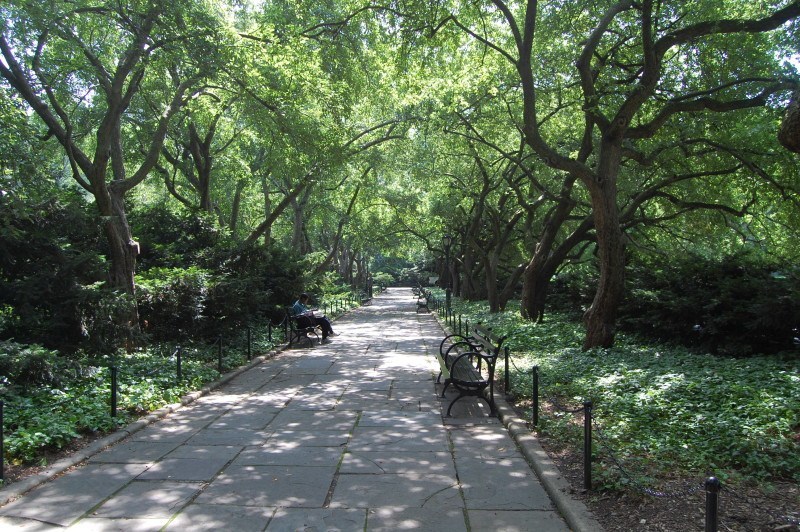
The spectacular Crabapple allee provides plenty of room to stroll and plenty of benches (modeled on the 1939 World’s Fair benches) upon which to relax.
Major walkways should be wide enough to allow ample room for walkers, runners and strollers. Secondary paths should be sufficient to allow traffic to flow with ease in both directions.
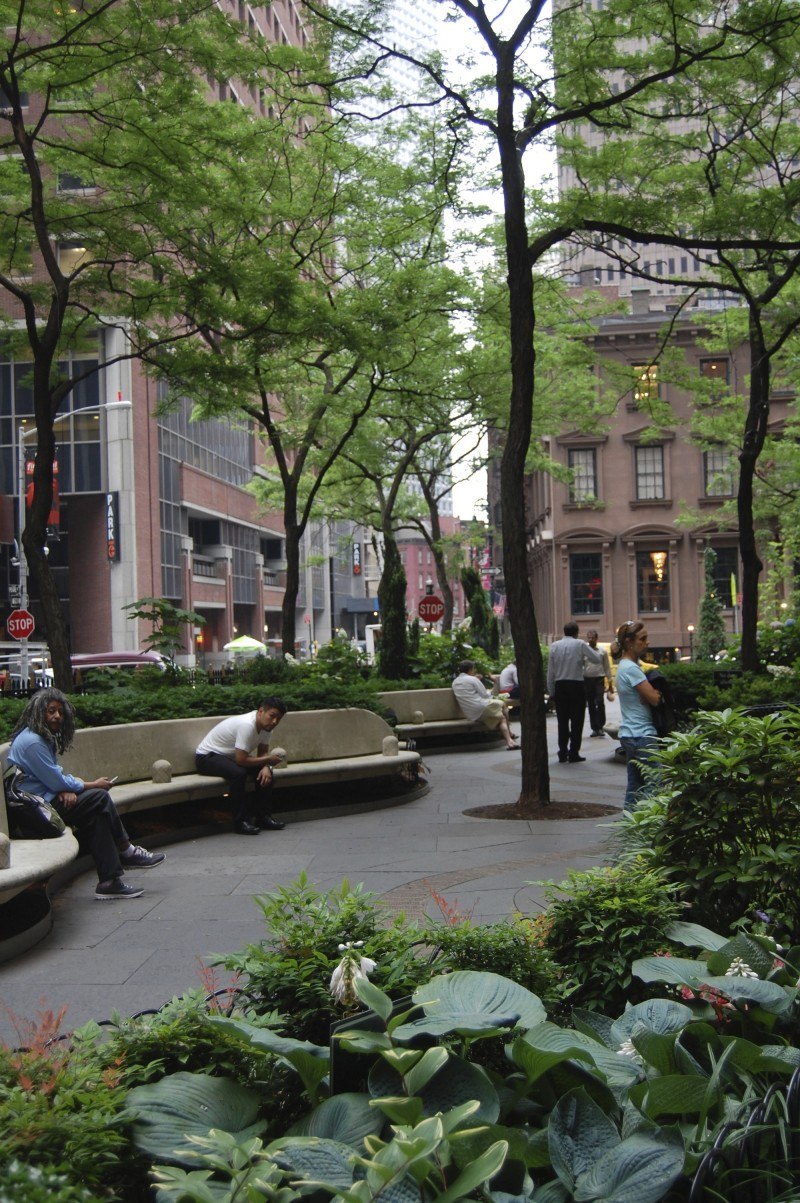
Although a small pocket park, the Queen’s Garden gives its neighbors beautiful plants, wide paths, plenty of seating, a canopy for shade and a nod to history. The park in Hanover Square is special to Lynden because her ancestor Susannah Rutgers Marshall, one of the only female business owners in the Eighteenth Century, owned Hanover Square. During a visit to the Virginia Museum of Fine Arts, Lynden was surprised to come face to face with Susannah’s portrait!
One of the most important amenities is also one of the most neglected: seating. Whether benches, seat walls, steps, lawns or chairs, they welcome a visitor to stay.
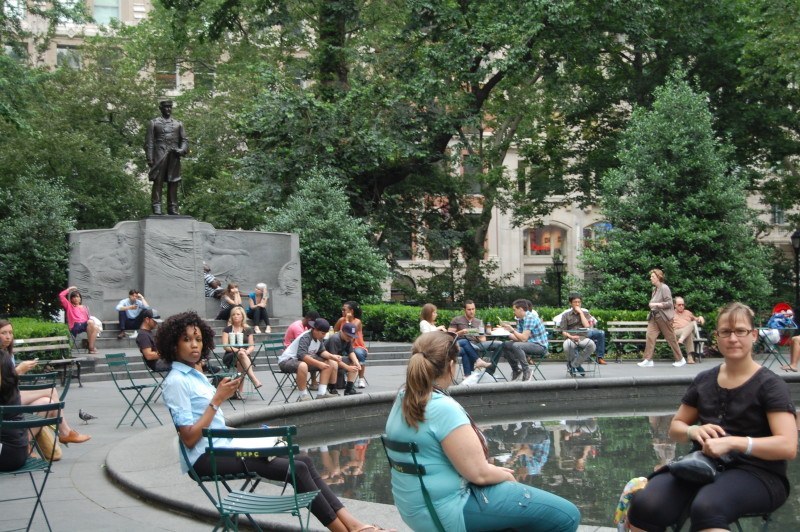
Large screens are brought into Madison Square Park during the U.S. Open, and hundreds of people gather during the work day to catch some of the action. Lynden sees Madison Square Park as a model for Richmond’s Monroe Park.
Probably the most questioned piece of advice that Lynden gives is to provide parks with moveable chairs. Holly Whyte found that people crave the feeling of control that comes with the ability to pick up a chair and move it to a desired location. He revolutionized urban parks when he introduced thousands of moveable chairs to New York’s Bryant Park. The city found that well-used parks did not suffer many chair thefts (yes there were a few), and the plan included a small percentage of extras to replace those that did go missing.
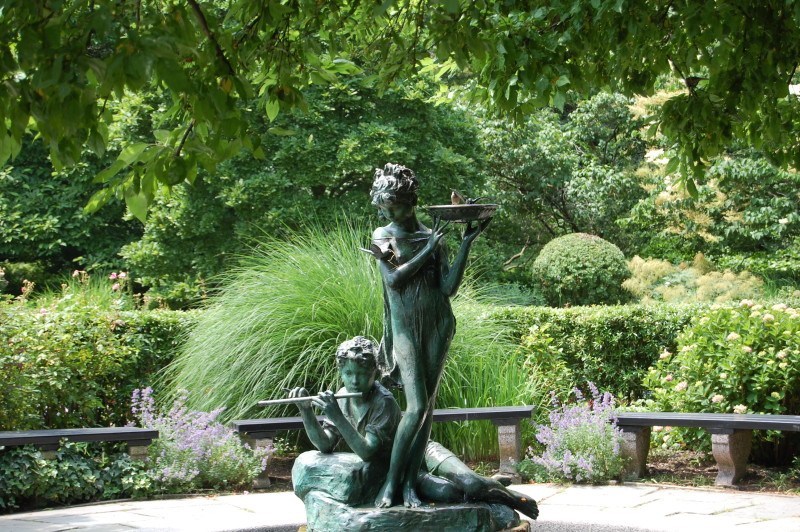
The sculpture of The Secret Garden’s Mary and Dillon in the center of a pool at the Conservatory Garden is the perfect backdrop for the scores of children who come to sit on the benches for story time. Dillon’s gentle lesson of nature’s transformative power on people is practiced every day in this special place.
While food is not a crucial element to public spaces, its inclusion is a huge draw. The day I was at Madison Square Park, lines at the Shake Shack stretched 100 yards. It’s not always practical for a city park to accommodate a food vendor. However, a bustling park will attract business to the surrounding area, including eateries.
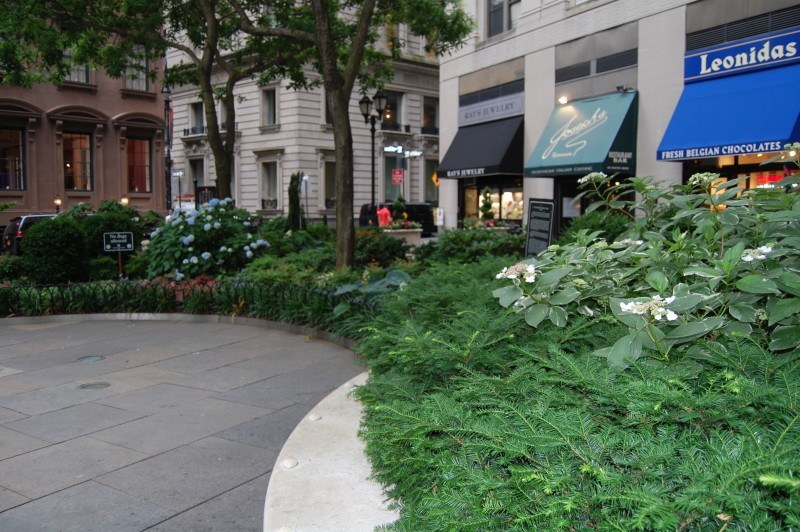
Small cafes, bars and coffee shops have sprung up around the Queen’s Garden. Urban gardens increase property values of surrounding businesses and residences.
We are at a crucial juncture in Richmond. We’ve been named the best river city in the nation, and we will be visited in two years by hundreds of thousands of cycling fans. Are we going to be ready for those visitors? Are we going to ride this momentum and make our historic city a welcoming green urban refuge?
The city is full of talented individuals, committed organizations and engaged businesses. We need to join together with our local government to cut through the red tape, reduce the bureaucratic road blocks and ensure that city ordinances and rules work to aid and entice, not inhibit, the realization of our city’s potential.
Lynden’s visit in January gave us hope that we can succeed as she has in New York. During Lynden’s visit to Richmond, local design professionals, city representatives, neighborhood and environmental groups, college representatives and business leaders gathered to discuss with Lynden current greening projects in Richmond. The meeting was so successful that Randee Humphrey at Lewis Ginter Botanical Garden now organizes bi-monthly “Beautiful RVA” meetings with the same constituents to discuss, promote and help facilitate the many projects aimed at making Richmond a more beautiful and livable city.
In the words of Lynden Miller, “Beautiful parks and gardens in a city are not a frill; they are essential to the well-being of its citizens.”
MID-SUMMER GARDEN CHORES
Since spring is now in the rearview mirror, it is time to . . .
CUT BACK HARDY GERANIUM, CATMINT AND LAVENDER
Cut flowering stems back once blooms begin to peter out. The plants will begin to bloom again in a few weeks. Gernanium x ‘Johnson’s Blue’ is pictured above.
PRUNE SHRUB AND CLIMBING ROSES
Prune vigorously growing shrub roses (like Knockouts) back at least 12 inches, cutting each branch to just above a 5-leaf stem, to keep the roses from growing too big. If you don’t mind them being 4 to 5 feet tall, just dead-head the spent clusters of blooms. Prune climbers as needed to train and keep under control. Feed roses every 6 weeks during the growing season (until early September).
CONTINUE TO CUT BACK LENTEN ROSE (HELLEBORUS) FLOWER STALKS AND LEAVES WHEN THEY BEGIN TO YELLOW
PRUNE STRAGGLY GROWTH OF EVERGREENS, IF NEEDED
FEED AND DEAD-HEAD ANNUALS TO KEEP THEM BLOOMING
REMOVE DYING FOLIAGE OF PLANTS GOING DORMANT
Virginia Bluebells (pictured above in background), Bleeding Heart, Arum and spring-flowering bulbs go dormant in summer. Once the foliage begins to brown you can cut it to the ground.
WEED!!!!!

